Posts Tagged ‘national parks’
Saturday, November 15th, 2014
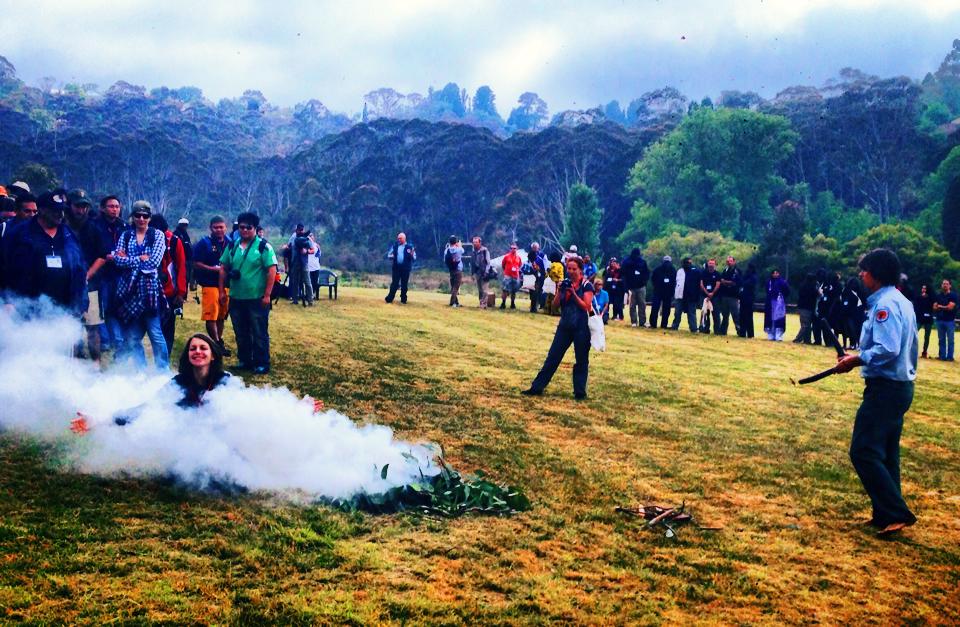 Smoking Ceremony or Smoke and Mirrors?
Staged for the delegates by National Parks and Wildlife Service of New South Wales (NPWS), somewhere outside Sydney, Australia
[Source: ‘Global First Nations environmentalists share stories at the World Parks Congress in Sydney.5:30’, ^https://twitter.com/nitvnews, 20141113] Smoking Ceremony or Smoke and Mirrors?
Staged for the delegates by National Parks and Wildlife Service of New South Wales (NPWS), somewhere outside Sydney, Australia
[Source: ‘Global First Nations environmentalists share stories at the World Parks Congress in Sydney.5:30’, ^https://twitter.com/nitvnews, 20141113]
.
Every ten years a World Parks Congress is a forum staged by the International Union for Conservation of Nature to discuss the effectiveness of World Heritage Listed Protected Areas. For 2014, Parks Australia put up Sydney’s hand to host and fund it.
<<“We (Parks Australia) are delighted to be co-hosting the IUCN World Parks Congress with our colleagues in the New South Wales National Parks and Wildlife Service – and look forward to welcoming inspiring leaders from around the world.”>>
IUCN’s vision is a “just world that values and conserves nature.” The theme for the 2014 conference is “Parks, people, planet: inspiring solutions”.
The last congress was in Durban, South Africa eleven years ago in 2003 and significant messages from that congress were that:
- Considerable progress has been made in the establishment of protected areas although significant gaps remain
- Protected areas face many challenges, and management effectiveness must be strengthened
- Protected areas play a vital role in biodiversity conservation and sustainable development
- A new deal is needed for protected areas, local communities and indigenous peoples
- There is a need to apply new and innovative approaches for protected areas, linked to broader agendas
- Protected areas require a significant boost in financial investment
- Protected areas management must involve young people
.
Congress Cost Benefits ?
.
The obvious first question for the 2014 Sydney Congress is what are the outcomes from these seven messages of 2003?
The second question is what is to be the conservation return on investment of staging the 2014 congress in Sydney? That starts with Parks Australia and NPWS disclosing the full costs of the congress. How much will it have cost by the time this week is over? Five million? Ten million? Twenty million? More? That also involves disclosure of the onground conservation outcomes, if any. The congress hosts more than 5000 delegates for a week-long event in Sydney.
If the answers are not forthcoming and/or the performances less than satisfactory, then perhaps the money could have been better spent (invested) by Parks Australia and NPWS on specific onground conservation of current and worthy Protected Areas in Australia. So the third question is what is the opportunity cost of the 2014 IUCN World Parks Congress which could have delivered the IUCN vision of a “just world that values and conserves nature”?
.
Congress Opportunity Costs
.
According to IUCN director general, Julia Marton-Lefevre, assessments during the past decade have found that half of the world’s protected areas at best — and possibly as few as 20 per cent — are managed effectively. “Some are what we refer to as ‘paper parks’ ” – parks just on paper.
The Australian Government’s $180 million allocation to expand the park reserve system expired last year.
The Great Barrier Reef Marine Park is a case in point. It is the iconic Protected Area in Australia. Its World Heritage listing along with various national zoning, management plans, permits, education and incentives are supposed to protect and conserve the marine ecosystems and migratory species from human threats. But farm and urban runoff continues to contaminate the rivers that flow into the Reef.
In 2009 and 2011, mining company Queensland Nickel discharged nitrogen-laden water and 516 tonnes of toxic waste water into the Great Barrier Reef.
On 21 July 2013, on the second day of the biennial joint training exercise Talisman Saber, two American AV-8B Harrier fighter jets launched from aircraft carrier USS Bonhomme Richard (LHD-6) dropped four bombs, weighing a total 1.8 metric tons (4,000 pounds), into more than 50 metres (164 ft) of water. On 3rd April 2010, The Shen Neng 1, a Chinese ship carrying 950 tonnes of oil, ran aground, causing the 2010 Great Barrier Reef oil spill.
In December 2013, Greg Hunt, the Australian environment minister, approved a plan for dredging to create three shipping terminals as part of the expansion of an existing coal port. According to corresponding approval documents, the process will create around 3 million cubic metres of dredged seabed that will be dumped within the Great Barrier Reef Marine Park.
On 31 January 2014, a permit was issued to allow three million cubic metres of sea bed from Abbot Point, north of Bowen, to be transported and unloaded in the waters of the Great Barrier Reef Marine Park, just outside of Abbot Bay. The dredge spoil will cloud the water and block sunlight, thereby starving sea grass and coral up to distances of 80 km away from the point of origin due to the actions of wind and currents. The dredge spoil will smother reef or sea grass to death, while storms can repeatedly resuspend these particles so that the harm caused is ongoing; secondly, disturbed sea floor can release toxic substances into the Great Barrier Reef Marine Park.
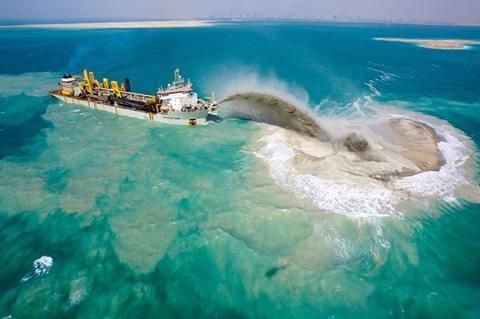 Dredging the Great Barrier Reef for bulk export shipping Dredging the Great Barrier Reef for bulk export shipping
.
The Great Barrier Reef Marine Park has become just a blue line on a map. The trickle of funds for Australia’s national parks betrays a lack of appreciation of their economic contribution. Annual funding for the authority that runs Australia’s most famous reserve, the Great Barrier Reef Marine Park, is about 1 per cent of the $5.2bn it earns the country in tourism revenue.
Yet if the IUCN World Parks Congress cost a conservative $20 million to stage then a key opportunity cost would be the June 2014 Federal budget cuts to the Great Barrier Reef Marine Park Authority.
The budget axed 17 staff including five of its’ directors positions. These positions included the director of heritage conservation, the director of policy and governance and the director of coastal ecosystems and water quality as part of an internal restructure. It’s being described as the greatest loss of expertise from Australia’s most important natural wonder and it comes at the very time the Great Barrier Reef is facing the greatest threat to its survival.
The Greater Barrier Reef Marine Park Authority has been reduced by the Australian Government to being in name only and ineffective at protecting the reef.
Until recently, one of those five directors, Adam Smith, was charged with dealing with the contentious Abbot Point coal terminal development and the proposal to dump three million cubic metres of dredge spoil into the marine park. Despite Dr Smith’s concerns, the sea dumping was approved by the Marine Park Authority.
Dr Smith has since accepted voluntary redundancy and moved on after disagreeing with the Authority’s new economic leadership and values. Heritage conservation director Jon Day has left after 21 years, disillusioned too with the direction the Authority has taken to compromise the reef.
Next year UNESCO will decide whether to put the reef on its world heritage in danger list. Native Dugongs are already endangered. The deliberate extermination of the dugong and turtles which habituated the Gladstone area is a national tragedy. Dugongs are species listed under the Federal Environment Protection Biodiversity & Conservation Act, which requires the Federal government to legally protect these animals.
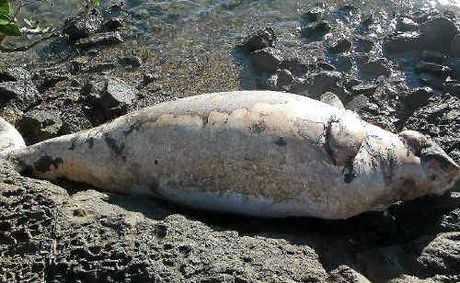
Prior to the massive dredging operation of 52 million cubic metres of seabed for the development of the world’s largest LNG Terminal, ( which is 62% completed) a study commissioned by the Gladstone Ports Corporation found that a take, or a quota, of more than zero dugongs would be unsustainable.
In the face of massive mortality of dugongs, turtles and inshore dolphins during the ongoing massive dredging, both the Federal and Queensland governments ignored the slaughter.
Look at the stranding data from the Queensland Department of Environment and Resource Management. Monthly cumulative Dugong strandings by year for Queensland, up to 31 January 2012.
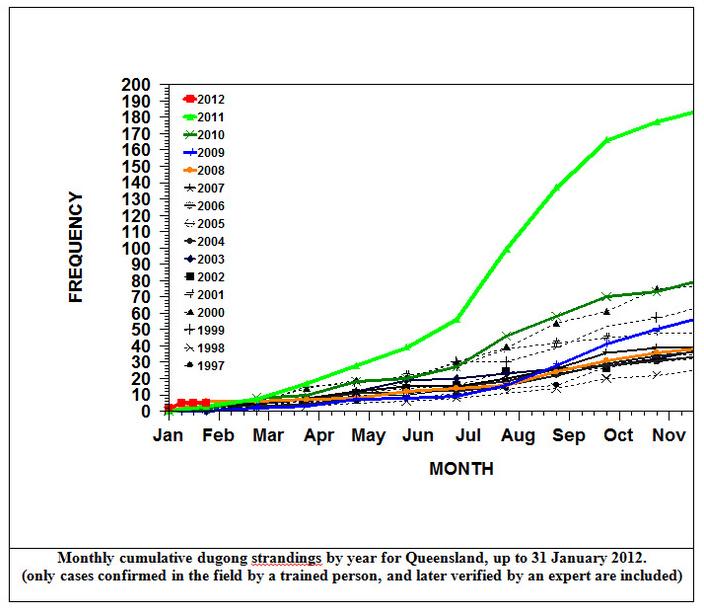
There are 22,000 vessel movements a month in Gladstone Harbour. No ship strikes of Dugongs or of Green Turtles need to be reported. No audit of environmental conditions has been undertaken by the Queensland or Federal Governments. The wholesale slaughter of our marine wildlife is the price Australians are paying for the transformation of the Great Barrier Reef World Heritage Area into the world’s largest unregulated quarry.
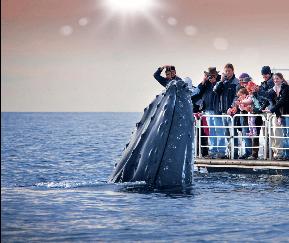 Mass tourism operators good for the economy
Getting up close to protected Humpback Whales within their 100 metre Protected Area Mass tourism operators good for the economy
Getting up close to protected Humpback Whales within their 100 metre Protected Area
.
Australian protected areas have seen rule changes in the eastern states have allowed cattle to graze, recreational shooters to hunt and hotel developers to build in national parks. Shore-based recreational fishing has been allowed in areas of NSW marine parks previously zoned as no-take sanctuaries. National parks on land and in the ocean are dying a death of a thousand cuts, in the form of bullets, hooks, hotels, logging concessions and grazing licences.
Yet as host of the 2014 World Parks Congress, Australia is showcasing “our own inspiring places, inspiring people and inspiring solutions.” The Global Eco Forum within the Congress programme focuses on tourism exploitation of Protected Areas because like the new Greater Barrier Reef Marine Park Authority, the new values are not about conservation by the billions in revenue opportunity to Australia’s economy.
The October 2006 issue of National Geographic published an article “The Future of Parks: Hallowed Ground – Nothing is Ever Safe”.
It stated:
“Landscape and memory combine to tell us certain places are special, sanctified by their extraordinary natural merits and by social consensus.
We call those places parks, and we take them for granted.”
.
Sydney’s 2014 World Parks Congress appears to be expensive window dressing, showcasing fraudulent conservation of Protected Areas in Australia.
It’s termed Greenwashing. The opportunity cost of the 2014 Congress could have instead funded the retention of the previously effective Great Barrier Reef Marine Park Authority and so done more for Protected Areas than all the pomp, promising, luncheons, showcasing, and talk-festing of the congress combined.
.
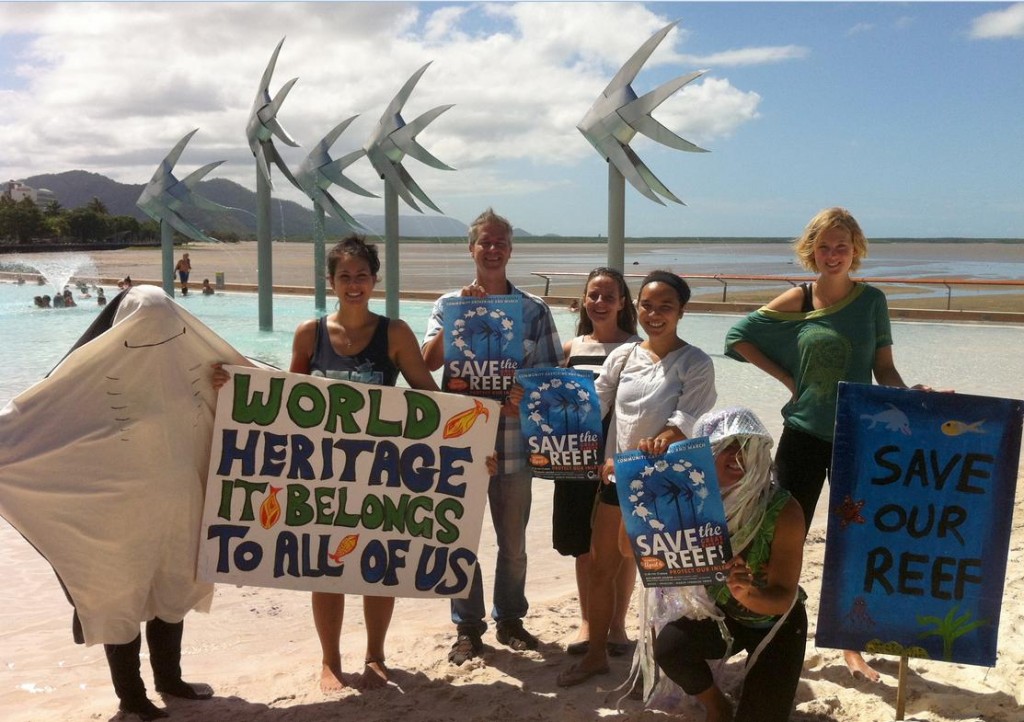 Protest to stop Queensland Resources Council dumping dredge spoil inside the Reef
Protest by Cairns and Far North Environment Centre (CAFNEC), June 2014
^http://cafnec.org.au/wp-content/uploads/2014/03/rally-promo-photo.jpg Protest to stop Queensland Resources Council dumping dredge spoil inside the Reef
Protest by Cairns and Far North Environment Centre (CAFNEC), June 2014
^http://cafnec.org.au/wp-content/uploads/2014/03/rally-promo-photo.jpg
.
Further Reading:
.
[1] IUCN World Parks Congress (Sydney 2014), International Union for Conservation of Nature, ^http://worldparkscongress.org/
.
[2] ‘Global Eco-Tourism in Protected Areas‘, by EcoTourism Australia, >2014 Global Eco Tourism in Protected Areas.pdf (1.1MB, 2 pages)
.
[3] Great Barrier Reef Marine Park Authority (website), Australian Government, ^http://www.gbrmpa.gov.au/
.
[4] Fight for The Reef (website), Australian Marine Conservation Society, ^https://fightforthereef.org.au/risks/dredging/
.
[5] No Hunting in National Parks (website), The National Parks Association of NSW, ^http://nohunting.wildwalks.com/
.
[6] ‘An international perspective on tourism in national parks and protected areas‘, by J.G. Castley (2014), >An international perspective on tourism in national parks and protected areas.pdf (100kb, 10 pages)
.
[7] ‘EXTRA: ‘Nasho’, Royal National Park, Sydney’s neglected southern jewel‘, by Nick Galvin, Journalist, Sydney Morning Herald, 20140613, ^http://www.smh.com.au/nsw/extra-nasho-royal-national-park-sydneys-neglected-southern-jewel-20140613-zs6d8.html
.
[8] ‘Paradise lost: Australia’s heritage jewels under threat‘, (audio), ABC ‘Background Briefing’ radio programme, by Sarah Dingle, 20131208, ^http://www.abc.net.au/radionational/programs/backgroundbriefing/2013-12-08/5132224
.
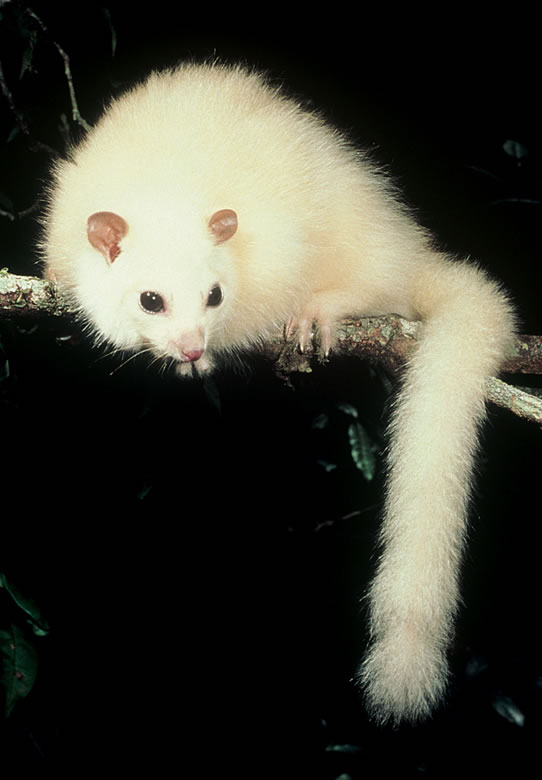 White Lemuroid Possum
(Wet Tropics of Queensland World Heritage Area in Danger)
Has the white lemuroid possum become the first mammal to go extinct due to global warming? White Lemuroid Possum
(Wet Tropics of Queensland World Heritage Area in Danger)
Has the white lemuroid possum become the first mammal to go extinct due to global warming?
The species, normally found above 1000m, has not been sighted during any nighttime spotlighting expedition since 2005. Experts fear a temperature rise of 0.8 degrees Celsius may be to blame for the animal’s disappearance.
[Source: ^http://www.wherelightmeetsdark.com/index.php?module=newswatch&NW_user_op=view&NW_id=453]
.
Tags: Dugong, Dugong strandings, Gladstone Harbour, Great Barrier Reef, Great Barrier Reef Marine Park, Green Turtle strandings, greenwashing, Humpback Whale, International Union for Conservation of Nature, iucn, national parks, National Parks and Wildlife Service, Parks Australia, Protected Areas in Australia, Queensland Government, The Great Barrier Reef Marine Park Authority, UNESCO world heritage in danger list, Wet Tropics of Queensland World Heritage Area in Danger, White Lemuroid Possum, World Heritage, World Parks Congress
Posted in Critically Endangered Wildlife (CR), Threats from Government Funding Neglect, Threats from Greenwashing, Threats from Pollution, Threats from Tourism and Recreation, Threats from Weak Environmental Laws | No Comments »
Add this post to Del.icio.us - Digg
Sunday, July 21st, 2013
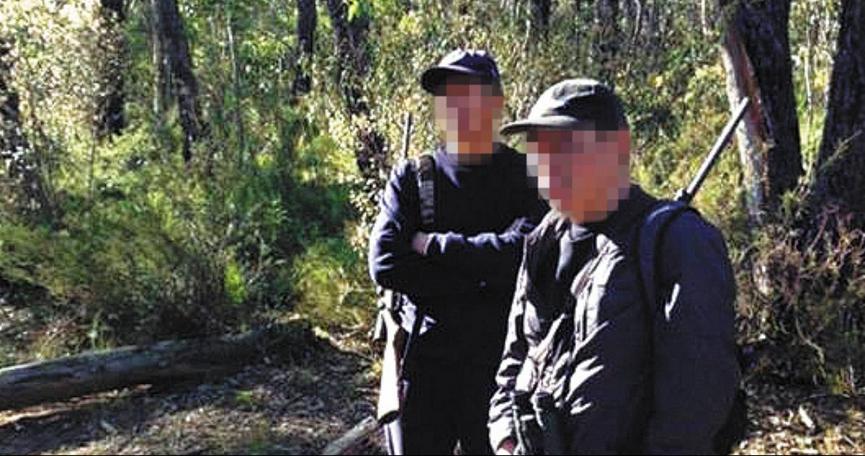 Illegal poachers caught in the Blue Mountains World Heritage Area on 15th June 2013
[Photo by bushwalker Darren Drew in Tigersnake Canyon, Wollemi National Park, at a time when 500 runners were participating in a marathon in the area] Illegal poachers caught in the Blue Mountains World Heritage Area on 15th June 2013
[Photo by bushwalker Darren Drew in Tigersnake Canyon, Wollemi National Park, at a time when 500 runners were participating in a marathon in the area]
.
<< Two men were reported to be illegally hunting in NSW’s biggest natural tourist attraction, the Greater Blue Mountains World Heritage Area.
Blackheath bushwalker Darren Trew said he came across the hunters on a canyoning trip with friends on Saturday June 15. Over that weekend 500 runners from across the state had converged in that same region to participate in the second Glow Worm Tunnel Marathon, near Newnes. Mr Trew, who saw the men with their weapons, reported the matter to Lithgow Police, to the Game Council and to the National Parks and Wildlife Service.
Mr Trew:
“It’s madness. It was quite a shock to discover after 20 or more years of bushwalking. It’s quite disturbing, they said they were hunting deer and I told them they were not allowed to be here with rifles, it’s illegal, I called the police and they walked away.”
.
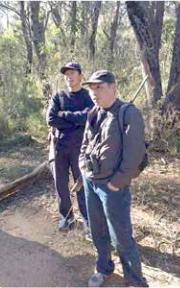 Photo by High & Wild Photo by High & Wild
.
Mr Trew’s group took a photo of the men and said later that day about 20 people turned up to enjoy Tigersnake Canyon.
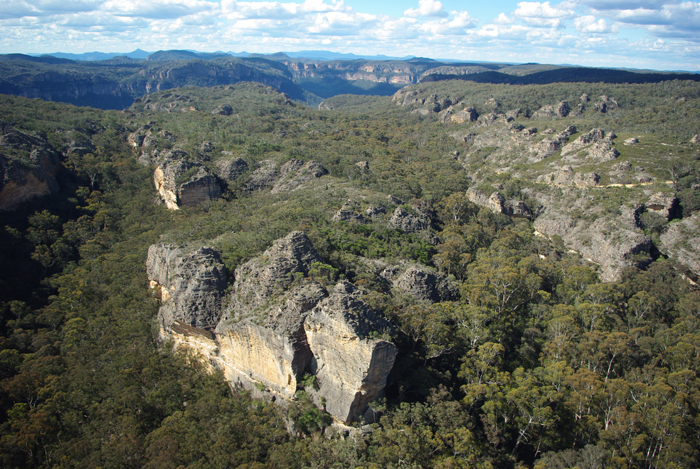 Glow Worm Tunnel Area, Wollemi National Park
Greater Blue Mountains World Heritage Area
[Source: NSW Government, ^http://www.environment.nsw.gov.au/nationalparks/parkWalking.aspx?id=N0051] Glow Worm Tunnel Area, Wollemi National Park
Greater Blue Mountains World Heritage Area
[Source: NSW Government, ^http://www.environment.nsw.gov.au/nationalparks/parkWalking.aspx?id=N0051]
.
Glow Worm Tunnel Marathon race director Sean Greenhill of the Wentworth Falls based Mountain Sports said he was very concerned by the reports.
“It’s extremely disturbing to think that two men with rifles were hunting in a national park only a couple of kilometres from where 500 runners were conducting a legitimate activity in the same park — odds are small but the potential implications are horrifying. Mountain Sports doesn’t support hunting in any national park — why create such a dangerous precedent?”
.
“Unfortunately, some hunters have heard “you can now hunt in national parks” and assume it’s a free-for-all. With the Game Council promoting NSW as ‘the place to hunt’, this is only going to get worse.”
~ National Parks Association of NSW spokesman, Justin McKee
.
National Parks Association of NSW spokesman, Justin McKee:
“The incident highlights that Premier Barry O’Farrell’s promise that safety will be paramount does not definitely rule out the risk of illegal hunting in highly visited areas, including those where hunting is not allowed like the Greater Blue Mountains World Heritage Area.
Hunting in national parks is bad policy, it’s bad for tourism, public safety and the environment. It ruins the international reputation of our national parks brand that has taken 50 years to build up. Unfortunately, some hunters have heard ‘you can now hunt in national parks’ and assume it’s a free-for-all.”
.
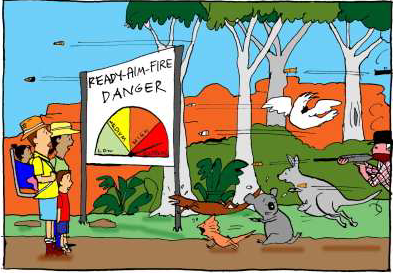
A spokesman for Environment Minister Robyn Parker said the minister didn’t normally comment on operational issues but “obviously hunting in national parks is illegal and an investigation is ongoing”… [Ed: There is no public report that they caught, so it was a free-for-all that day]
[Source: ‘Armed hunters spotted in Blue Mountains world heritage area’, 20130626, by B. C Lewis, Blue Mountains Gazette (newspaper), page 7, ^http://www.bluemountainsgazette.com.au/story/1598489/armed-hunters-spotted-in-blue-mountains-world-heritage-area/; the lead photo of the two hunters was taken near Tigersnake Canyon and posted on Facebook 20130622]
.
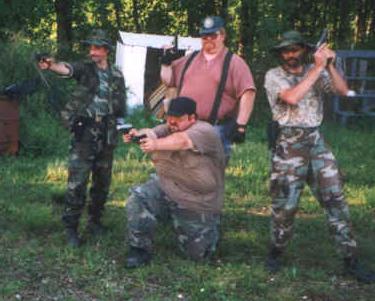 Weekend Warriors
all camoued up and ready to hunt! Weekend Warriors
all camoued up and ready to hunt!
.
Game Council NSW ‘Code of Practice’ (so-called)
.
<< Ethical, safe and responsible hunting
.
- Awareness of relevant legislation
It is the responsibility of the holder of a NSW Game Hunting Licence to be aware of and comply with all relevant legisation relating to hunting, animal welfare and the use of firearms.
- Safe handling of firearms
Where firearms are used, the rules for safe handling set out in the NSW Firearms Safety Awareness handbook, published by or under the authority of the Commissioner of Police, must be complied with at all times.
- Permission required to enter land
A NSW Game Hunting Licence does not automatically authorise the holder of a licence to hunt on any land. The holder of a Game Hunting Licence must not hunt on any land without the express authority of the occupier of the land.
- Target identification and safety
A game animal must not be fired at unless it can be clearly seen and identified, and the shot taken poses no discernible risk of injury to any person or damage to any property.
- Obligation to avoid suffering
An animal being hunted must not be inflicted with unnecessary pain. To achieve the aim of delivering a humane death to a hunted animal:
- it must be targeted so that a humane kill is likely;
- it must be shot within the reasonably accepted killing range of the firearm and ammunition or bow being used; and
- the firearm, ammunition, or bow and arrow, must be such as can be reasonable expected to humanely kill and animal of the target species.
- Lactating female with dependent young
If a lactating female is killed, every reasonable effort must be made to locate and kill any dependent young.
- Wounded animals
If an animal is wounded, the hunter must take all reasonable steps to locate it so that it can be killed quickly and humanely.
- Use of dogs
Dogs and other animals may be used to assist hunters, but only if:
- their use is not in contravention to the Prevention of Cruelty to Animals Act 1979; and
- their use is with the permission of the occupier of the land concerned. >>
.
[Source: Game Council of NewSouth Wales, ^http://www.gamecouncil.nsw.gov.au/portal.asp?p=CodeofPractice]
.
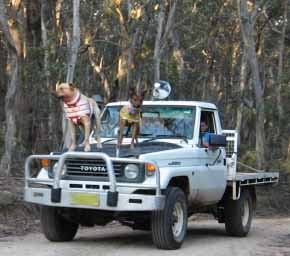 Game Council Code of Practice:
“Use of (pig) dogs: Dogs and other animals may be used to assist hunters, but only if: Game Council Code of Practice:
“Use of (pig) dogs: Dogs and other animals may be used to assist hunters, but only if:
-
their use is not in contravention to the Prevention of Cruelty to Animals Act 1979; and
-
their use is with the permission of the occupier of the land concerned.”
.
May 2012: NSW Government allows hunting in national parks
.
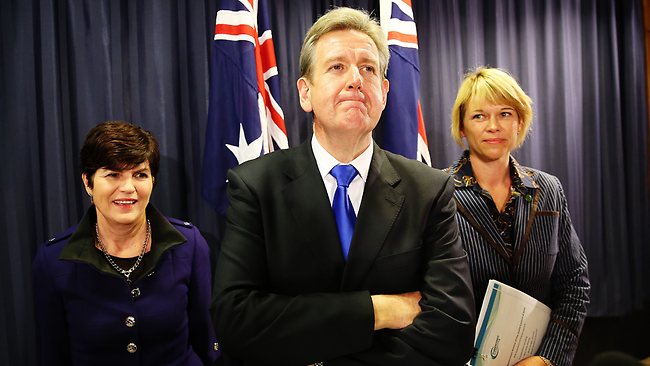 National Park’s chief custodian Environment Minister Robyn Parker,
with NSW Premier Barry O’Farrell and Primary Industries Minister Katrina Hodgkinson
announcing that shooting will be legal in national parks.
[Source: Photo by Craig Greenhill, The Daily Telegraph] National Park’s chief custodian Environment Minister Robyn Parker,
with NSW Premier Barry O’Farrell and Primary Industries Minister Katrina Hodgkinson
announcing that shooting will be legal in national parks.
[Source: Photo by Craig Greenhill, The Daily Telegraph]
.
<< Hunting will be seen in 79 of the state’s national parks as part of a deal struck by the government (with the Christian Democrats and the Shooters and Fishers Party) last night in exchange for the sale of the state electricity generators.

New South Wales Premier, Barry O’Farrell: “We promised to revitalise the state’s economy, we promised to put additional funding into infrastructure… and the decision was based on the public interest and political realites.”
Despite O’Farrell’s pre-election promise that he would not open up national parks to shooters as hunting reserves, the Premier said that he has not broken his promise.
“There is a big difference between hunting reserves and restricted shooters under the direction of the Minster of the Environment assisting National Parks and Wildlife staff with the culling of feral animals.”
O’Farrell’s famous last words:
“Shooting will be safely and professionally run by the Game Council.”
.
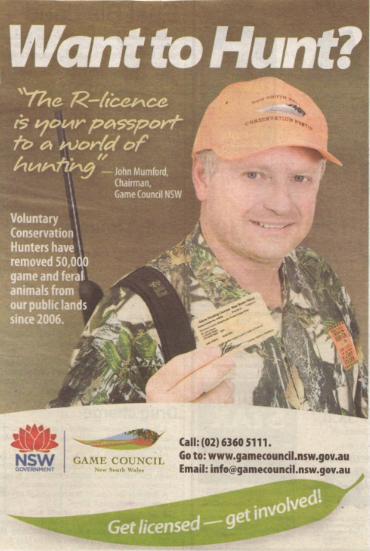
In exchange for the hunting deal Premier O’Farrell will now be able to sell off the state’s generators as recommended by the State’s Commission of Enquiry…>>
[Source: ‘Premier O’Farrell to allow hunting in NSW national parks’, 20120531, by Amy Taylor-Kabbaz, Australian Broadcasting Corporation, ^http://www.abc.net.au/local/stories/2012/05/31/3515093.htm]
.
ABC radio interview by radio presenter Adam Spencer with Premier Barry O’Farrell, 20120531:

Listen to ABC radio interview
.
[Ed: So a month later on 27th June 2012, the NSW Coalition Government, the Shooters and Fishers Party and the Christian Democratic Party voted in changes to legislation that allows amateur, recreational hunting to occur in NSW National Parks.]
.
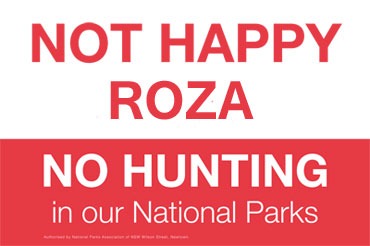 Blue Mountains protest campaign against the NSW Government’s local representative, Roza Sage MP,
and her undemocratic support for hunting in national parks across New South Wales. Blue Mountains protest campaign against the NSW Government’s local representative, Roza Sage MP,
and her undemocratic support for hunting in national parks across New South Wales.
.
Two weeks later, on Sunday 15th July 2012, about 400 people rallied in Katoomba in the Blue Mountains to protest against Barry O’Farrell’s decision and to tell local Blue Mountains MP Roza Sage that they oppose the Government’s decision to allow hunting in our National Parks.
.
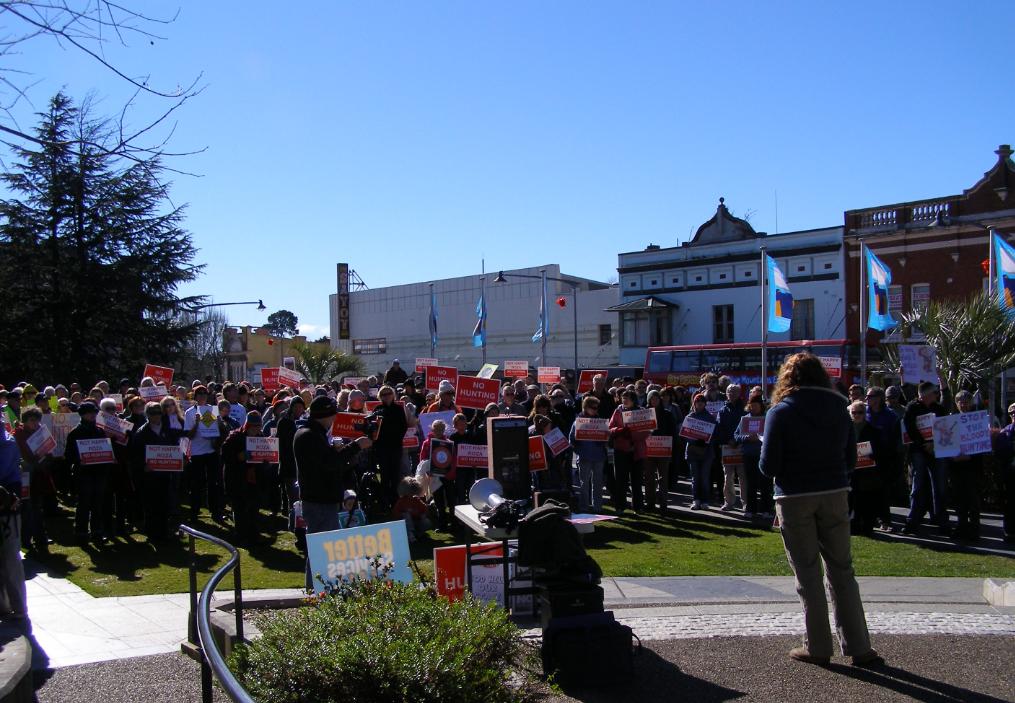 No Hunting in National Parks Rally at Katoomba
[Photo by Editor 20120715, photo © under ^Creative Commons] No Hunting in National Parks Rally at Katoomba
[Photo by Editor 20120715, photo © under ^Creative Commons]
.
Kangaroo shot with arrow in Kosciuszko National Park
.
 Conservation Hunting Conservation Hunting
.
This kangaroo was discovered, still alive, two days ago near Log Bridge Creek picnic and camping ground on the Blowering Foreshore inside the Kosciuszko National Park, with the arrow right through its upper body.
<< An illegal hunter shot a kangaroo with an arrow and left it wounded near a camping area in the Kosciuszko National Park.
The roo was discovered yesterday near the Log Bridge Creek picnic and camping area on the Blowering Foreshore and was put down by parks officers.
NSW National Parks and Wildlife Service regional manager Dave Darlington:
“This roo spent an unknown time with an arrow pierced fully through its body and the cruelty and atrocity of this act is horrific. This is a senseless and disgusting act and we hope to prosecute the person responsible to the furthest limits of our legislation.”
Anyone with information is urged to phone NPWS on (02) 6947 7000 or Crime Stoppers on 1800 333 000.
.
Harming protected wildlife carries penalties of $11,000 an incident and up to six months jail while having a bow and arrow in a National Park also carries a fine of up to $3,300.
.
The National Parks and Wildlife Service had to euthanise a kangaroo.
[Source: ‘Kangaroo found shot with arrow’, 20130703, ABC News, ^http://www.abc.net.au/news/2013-07-03/kangaroo-found-shot-with-arrow/4796178]
.
National Parks and Wildlife Service does drug deal with hunters
.
<< A National Parks and Wildlife Service ranger was stood down for allegedly letting hunters into the Paroo-Darling National Park in the state’s far west in exchange for drugs.
The government confirmed there had been 12 investigations of illegal hunting in national parks in the past year.
The state government is soon to decide whether to press ahead with its plans to allow shooting in national parks. Allowing hunting in national parks was agreed to in a deal between the government and the Shooters Party so the Shooters would pass the $5 billion sale of the ports through the upper house. Premier Barry O’Farrell is expected to take a risk assessment on the hunting plan to cabinet in the next fortnight at the same time as a review by former senior public servant Steve Dunn on the structure of the shooting regulator, the Game Council.
The Dunn report was ordered after the acting chief executive of the Game Council was allegedly caught illegally shooting on the eve of the intended opening of national parks to shooters. Mr Dunn’s report will recommend that all shooting advocates and members of the Shooters Party no longer serve on the board of the Game Council, because of a clear conflict between the roles of advocate and regulator. [Ed: Download the Dunn Report at the end of this article]
Illegal hunters trespassing on private land in metro Sydney
.
<< Hunters using guns and crossbows have been illegally entering private properties in metropolitan Sydney, forcing ecologists to abandon night-time observation of frogs and owls for fear of being shot.
Incidents have occurred in the past fortnight in north-west Sydney, just a few kilometres from housing, according to UBM Ecological Consultants’ Judith Rawling. The situation has become dangerous for her staff, she said, and she attributed the surge in illegal hunting to publicity over the looming introduction of hunting in national parks.
Local environment planning drafts for the Hills Shire have been released, prompting residents of bush blocks to apply for subdivisions.
”Before you put in a [development application] you have to put in a flora and fauna survey … That’s why we are coming across these shooters. This is really dangerous,” she said.
Game Council NSW was unavailable for comment.
Greens MP and firearms spokesman David Shoebridge:
“If local councils, the police and Game Council can’t control illegal hunting in the Hills Shire, there is no way on earth they will be able to regulate amateur hunting in far-flung national parks.”
.
[Source: ‘Hunters prowl across private land near city’, 20130630, by Kirsty Needham, Sydney Morning Herald (newspaper), ^http://www.smh.com.au/environment/animals/hunters-prowl-across-private-land-near-city-20130629-2p3v4.html]
.
Hunters shoot at a farmer near Game Council headquarters
.
May 2013:
.
<< Orange police are looking for two men who shot at a Springside farmer yesterday morning when he caught them illegally hunting on his property. [Ed: Springside is a community just south of Orange in central western New South Wales, where the Game Council of NSW has its headquarters].
The 43-year-old landowner was bailed up at gunpoint and ordered to drop his mobile phone which he was using to take a photograph of the offenders’ number plate. One of the gunmen smashed the phone and fired a warning shot at the man’s feet.
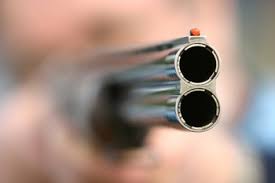
The farmer had challenged the men after he found them on his property hunting kangaroos. [Ed: Conservation Hunting?]
Canobolas Local Area Command Inspector Dave Harvey said the two men were less than four metres away from the farmer when they shot at him.
A command post was set up at Springside shortly before 10am where five police, detectives and the forensics special group combed through bushland in the Canobolas State Forest for two hours looking for the men. One of the men was wearing a grey top and black tracksuit pants. He is described as Caucasian, about 180cm tall, thin build with short dark hair and is between 17 and 24 years old. They were driving a white Subaru Outback.
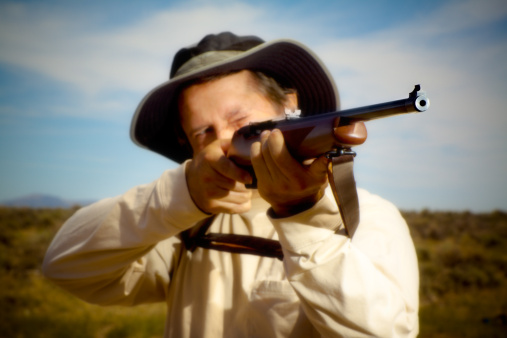
June 2013:
.
<< Orange police have charged an 18-year-old man over last month’s shooting at Springside. The man is believed to be one of two people who shot at a farmer while illegally shooting on his property on May 21 at around 9.30am.
The alleged shooter was arrested in Orange’s central business district at around 11.50pm yesterday. Yesterday afternoon police obtained a search warrant for his Moad Street apartment where they found a number of items which police believe may be associated with the gun used in the shooting. Canobolas Local Area Command Acting Inspector Brenden Turner said police had not located the firearm. >>
.
[Source: ‘Hunters shoot at property owner’, 20130522, by Nicole Kuter, Central Western Daily (Orange-based newspaper),^http://www.centralwesterndaily.com.au/story/1517209/hunters-shoot-at-property-owner/; and ‘Hunter Police get their man: charges over hunting shooting’, 20130627, by journalist Tracey Prisk, Central Western Daily, ^http://www.centralwesterndaily.com.au/story/1599702/police-get-their-man-charges-over-hunting-shooting/?cs=103]
.
NSW Game Council bosses above the law?
.
<< The state government’s plan to allow hunting in national parks is in turmoil after the acting head of the Game Council was stood down on suspicion of illegal hunting.
The council is the body that will issue shooting licences under the scheme. Its acting chief executive, Greg McFarland was suspended on Tuesday night – along with a colleague – by the Primary Industries Minister, Katrina Hodgkinson, after Fairfax Media learnt of a police investigation into an incident near Mount Hope in central west NSW.
 Game Council’s acting chief executive, Greg McFarland
is currently the subject of continuing investigations
[Source: ‘Game Council to be abolished’, 20130704, by Sean Nicholls, Sydney Morning Herald State Political Editor Game Council’s acting chief executive, Greg McFarland
is currently the subject of continuing investigations
[Source: ‘Game Council to be abolished’, 20130704, by Sean Nicholls, Sydney Morning Herald State Political Editor
http://www.smh.com.au/nsw/game-council-to-be-abolished-20130704-2pdte.html]
.
<< Rural crime investigators confirmed they are looking into claims of illegal hunting and trespass and the inhumane killing of a feral goat. They plan to interview Mr McFarland…
At the centre of the investigation is a Game Council vehicle that was seen being driven through a national park without permission before allegedly breaking a fence and entering the privately-owned Karwarn cattle station in pursuit of a male goat with ”trophy horns”.
.
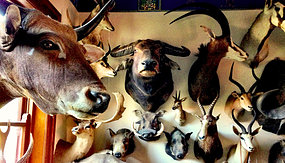 The Hunting Party
(Photo by Louie Eroglu) The Hunting Party
(Photo by Louie Eroglu)
.
According to photographs taken by the owner of the 25,000-acre property, Diane Noble, the goat was shot in the gut – an act that contravenes the council’s own guidelines on humane, ”single shot” kills. Hunters sometimes avoid shooting a goat in the head to ensure the skull and horns can be hung as a trophy.
The incident happened on December 28 at the Noble’s Karwarn station, 110 kilometres south of Cobar. According to Ms Noble, the pair were confronted by a group of hunters who had paid to shoot at Karwarn. To access Karwarn, the pair had to drive through the Yathong Nature Reserve, run by the National Parks and Wildlife Service. A parks source confirmed they did not have appropriate permission to do so.
.
“If local councils, the police and Game Council can’t control illegal hunting in the Hills Shire, there is no way on earth they will be able to regulate amateur hunting in far-flung national parks.”
~ Greens MP and firearms spokesman David Shoebridge
.
..The suspensions call into question the O’Farrell government’s insistence that shooting will be safely and professionally run by the Game Council, which will issue licences and monitor compliance when shooting begins on March 1. Critics said the government must now reconsider its deal with the Shooters and Fishers Party to put the council in charge or abandon hunting in national parks altogether.
Steve Turner, the assistant general secretary of the Public Service Association, which represents park rangers, said: ”How can anyone have faith that hunting in national parks will be run safely? Imagine what’s going to happen when the rogues get going.”
The scandal comes a month after a risk assessment written by Premier Barry O’Farrell’s own department emerged, warning of a ”major risk” that bushwalkers and parks staff will be killed or seriously injured.
Ms Noble said she did not want to prejudice the investigation but was angered by the apparent conduct. ”The Game Council is supposed to promote ethical hunting. They shot the goat through the guts and that’s not ethical,” she said. ”The animal should be shot once in the head or the heart and lungs for a quick kill.” >>
.
[Source: ‘Game boss suspended over illegal hunt claim’, 20130123, by Heath Aston (political reporter), Sydney Morning Herald, ^http://www.smh.com.au/nsw/game-boss-suspended-over-illegal-hunt-claim-20130122-2d5nn.html]
.
July 2013: Time to Wind Up the Game Council racket
.
Dunn’s Review into the Governance of the Game Council was commissioned by the Government after an internal investigation into allegations that a senior member of the Council had been involved in the inhumane killings of the goat in Western NSW.
.
<<On Thursday 4 July 2013 the NSW Government announced it will implement the key changes to Game Council NSW recommended by the independent Governance Review of the Game Council of NSW by Steve Dunn, popularly referred to as The Dunn Report.
The changes are designed to improve the functions previously carried out by Game Council NSW and also acknowledge hunting as a legitimate recreational activity.
The report found that Game Council NSW had an ‘inherent conflict associated with its functions to both represent the interests of hunters, and to regulate their activities’.
Therefore the NSW Government said it will immediately take the following actions:
- Transfer the licensing, regulatory, enforcement, education and policy functions into the NSW Department of Primary Industries (DPI); and
- Establish an advisory Game Board that will undertake stakeholder engagement and representation, advocate hunting, advise on research priorities and commission research, and provide independent advice to Government.
The Director General of NSW Trade & Investment, Mr Mark Paterson AO, will become the Division Head of the Game Council Division in the interim to oversee the integration of functions into DPI.
The NSW Government also announced it will immediately suspend hunting in all 400 State forests, pending the transfer of functions and the outcome of a risk assessment. This means that individuals with written permission to hunt on declared public land areas such as State forests and Crown Lands must no longer do so and must abide by the suspension until further advised.
Game Council and the Forestry Corporation of NSW will be contacting licence holders who have booked Written Permissions as soon as possible. Advice is also being sought from the NSW Government on the status of licensing arrangements.
Game Bird Management regulatory functions will continue to be undertaken by the Office of Environment and Heritage in 2013 and will transfer to DPI in 2014.
.
Game Council NSW Media Statement
.
<<On Thursday 4th July 2013, the Minister for Primary Industries announced the dissolution of Game Council NSW as a result of recommendations made following the NSW Government’s governance review.
The NSW Government has suspended hunting in all NSW State forests, pending a new risk assessment. All issued Written Permissions are now invalid. Game Council and the Forestry Corporation of NSW will attempt to call all licence holders with bookings to confirm cancellation of their permits in the coming week.
Game Council is committed to working with the NSW Government as the report recommendations are implemented and will also be working closely with NSW game hunting licence holders to minimise the impact of interim arrangements. >>
[Source: Game Council NSW website, ^http://www.gamecouncil.nsw.gov.au/]
.
..Minister for Primary Industries (DPI), Katrina Hodgkinson MP said nominees for the board would be ministerially appointed based on merit and all existing 21 staff under the current Games Council would be transfered to the new structure under the DPI.
She said key in her decision to support Steve Dunn’s report recommendations was its finding that “more than a decade after it was established the Game Council has no overarching governance framework; lacks a strategic planning framework; lacks some of the skills, tools and resources to ensure effective compliance with its regulatory framework; has no internal regulatory compliance program, has no approved enterprise-wide risk management framework and has an inadequate policy framework”.
“I can’t just stand by and allow that to continue – I take full responsibility for the changes,” Ms Hodgkinson said.
She said one of her primary concerns was for staff employed in the area of compliance and their safety, but she also saw the need to restore confidence in the public in this area. >>
.
COMMENT by ‘Dickytiger’ 20130705:
.
“Good move. The Game Council was just a Shooters Party lurk, looking after their mates.
Hunting feral animals is vital, but it doesn’t require a crony bureaucracy to do it.”
.
[Source: ‘Game over as hunting suspended’, 20130704, by Andrew Norris, The Land (rural newspaper), ^http://www.theland.com.au/news/agriculture/general/news/game-over-as-hunting-suspended/2663149.aspx?storypage=0]
.
Game Council NSW to be abolished
.
<< Amateur hunting in NSW forests will be suspended until at least October following the damning findings of a review into the Game Council of NSW.
As a result of the review, by retired public servant Steve Dunn, the Game Council of NSW will be abolished and responsibility for licensing of amateur hunters transferred to the Department of Primary Industries, the state government announced on Thursday.
The concerns raised in the review have led the government to announce the suspension of all amateur hunting in state forests until governance issues identified within the council are resolved.
In a simultaneous announcement, Environment Minister Robyn Parker revealed the introduction of amateur hunting to national parks will proceed in October, but on a trial basis in 12 parks. Pending the results, hunting may be rolled out in up to 75 parks and reserves as previously announced by the government under a deal with the Shooters and Fishers Party.
Ms Parker said the rules for shooting in national parks would be significantly different to those in place for state forests. Shooters would be closely supervised by National Parks and Wildlife staff in all areas where shooting takes place, which will be closed to visitors for the duration. Shooting will not take place during school holidays.
Additionally, no one under 18 would be allowed to participate, and use of bows or black powder muskets would be prohibited.
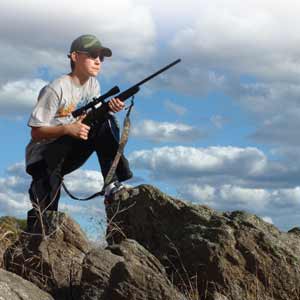
The Dunn report, released on Thursday, slams governance the Game Council, which it says is ‘‘deeply embedded in politics’’.
In a scathing assessment, Mr Dunn says public safety ‘‘does not receive a high level of attention’’ in planning documents prepared by the organisation, which is responsible for overseeing licensing of amateur shooters in NSW.
He says the council has been unable to resolve the ‘‘inherent conflict of interest’’ between representing the interests of hunters and regulating their activities in NSW.
The report says the council has ‘‘achieved significant results’’ since its establishment in 2002. But they have been achieved ‘‘at the taking of governance risks not normally associated with government bodies.’’
It concludes: ‘‘Allowing the Game Council to continue on its current path is not an option.’’
The review was ordered by Mr O’Farrell in March after an investigation found alleged illegal hunting by two Game Council senior employees on a property in outback NSW.
.. The IAB report also identified ‘‘possible breaches of Game Council policies and procedures, information which raises questions about governance procedures within the Game Council’’.
Sensitivity over the allegations were heightened by the decision by Mr O’Farrell to open NSW national parks to amateur hunting.
The decision was part of a deal between the government and the Shooters and Fishers Party, which holds the balance of power in the upper house, over passage of electricity privatisation legislation.
Mr Dunn’s report notes that the Game Council was established in 2002 because of the ‘‘influence and power’’ of the Shooter and Fishers Party. He says this power has resulted in the creation of an organisation lacking in accountability.
Shooters and Fishers Party MP Robert Brown is a former Game Council chairman.
More than a decade after the Game Council was established, a strategic plan has yet to be finalised and made public, Mr Dunn notes. His report recommends the 18-member Game Council be replaced by a NSW Game Board of not more than eight members.
It would be subject to control of the department and be responsible for representing the interests of hunters, promoting feral animal control and providing policy advice to government.
However, licensing, education and law enforcement functions – currently the chief role of the Game Council – would be handed to a government department, along with policy and legislation functions. Reaction is being sought from Game Council chief executive Brian Boyle and the Shooters and Fishers Party. >>
[Source: ‘Game Council to be abolished’, 20130704, by Sean Nicholls, Sydney Morning Herald State Political Editor, ^http://www.smh.com.au/nsw/game-council-to-be-abolished-20130704-2pdte.html]
.
Hunting on NSW public land will be banned for at least the next two months and the Game Council will be disbanded. Yet the NSW Government is going ahead with its plan to allow volunteer hunters in national parks as part of a pest control program.
It’s a bold decision, which the Shooters and Hunters Party says even it had no idea was coming. This decision stems from the results of the Government commissioned Dunn Review into the governance of the Game Council. >>
.
Dunn’s Scathing Review
.
Dunn’s Review into the Governance of the Game Council was commissioned by the Government after an internal investigation into allegations that a senior member of the Council had been involved in the inhumane killings of a goat in Western NSW.
The final report acknowledged the Council had achieved many things in its years of operation but for the most part the report was undeniably shocking leaving the Government no choice but to take action.
Its author Steve Dunn questions how things got so bad. He found the Council has no overarching governance framework, lacks the skills and resources to ensure effective compliance and found breaches of record keeping and privacy legislation. The Game Council is a statutory body established under the Game and Feral Animal Control Act – and it should be subject to the control and direction of the Minister for Primaries Industries.
But Premier of NSW, Barry O’Farrell, says the Council strayed.
“Essentially it made the point that the Game Council was both the promoter and the operator in relation to hunting activities across NSW as well as the regulator,” he said. “That posed an unacceptable risk to the Government.”
The review found the Game Council has its fingers deep in the political pie, with the slices getting bigger thanks to the influence and power of the Shooters and Fishers Party in the NSW Legislative Council.
Steve Dunn wrote, “the Game Council has no parent and no siblings, no one wants to adopt it and no one really wants a close relationship with it, because of the politics.”
Shooters Party MP, Robert Brown, says he hasn’t yet had time to fully consider the O’Farrell Government’s announcement. But he says he’s personally disappointed the Game Council has been abolished and will be seeking a meeting with the Premier before he forms the Party’s response.
The Game Council will be replaced by an advisory board of no more than eight members, which will each be selected on merit, rather than being appointed by various organisations. The board will be in charge of advocacy. The regulatory aspect of the Council will now go to Department of Primary Industries.
Minister Katrina Hodgkinson says no Games Council jobs will be lost in the transition and, until that situation is fixed, shooting in state forests has been put on hold.
“It’s a hard thing to have to go through and accept a report which is so critical of an organisation. But we’ve got an opportunity now to make things right and make things good. We’ll be transferring the operations of the Game Council over into the Department of Primary Industries, which does have excellent governance.”
The temporary shooting stoppage will affect 400 state forests and 2 crown lands. However the Government is going ahead with its pest control program National Parks.
A trial in 12 parks will commence in October. The Environment Minister Robyn Parker says it will be regulated and managed by the National Parks and Wildlife Service, and there will be strict controls and supervision.
The Minister acknowledged the 20,000 hunters in NSW that assist the Government with pest animal control in NSW.
“These hunters have played an important role in pest eradication.”
The Game Council and the Shooters and Fishers Party have been contacted for comment.
A one time candidate of the Shooters and Fishers Party says he’s always had concerns about the way the Game Council has been run. Jim Pirie is from Mudgee in New South Wales and has over 60 years of hunting experience under his belt, he was also a one-time candidate of the Shooters and Fishers Party. These days he’s the owner of a gun shop in town and he’s also the Treasurer of the Cudgegong Valley Hunters Club.
He spoke with the ABC’s Angela Owens frankly about his concerns over opening National Parks up to hunters and the growing power base of the Game Council.
.
“Unfortunately the architects of all this are very egotistical, arrogant men and they won’t take advice from anybody,” he said. “It’s either their way or the highway.”
.
“(Someone) stood up at a hunting organisation meeting one day and said there was no nepotism, no cronyism in the Game Council, well that was a joke.
“They appointed the people that they wanted and this at the end of the day was to the determent of the organisation.” >>
.
[Source: ‘NSW Government abolishes Game Council’, 20130705, by Skye Manson, Lisa Herbert and Angela Owens, ABC Rural, ^http://www.abc.net.au/news/2013-07-05/nrn-game-council-gone/4800282]
.

.
July 2013: Cowboy shooters are finished in NSW
.
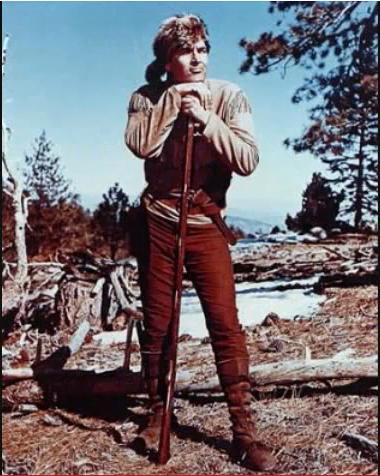 Daniel Boone was a big man Daniel Boone was a big man
.
“DANIEL BOONE”
lyrics by Vera Matson, music by Lionel Newman
.
<< Daniel Boone was a man,
Yes, a big man!
With an eye like an eagle
And as tall as a mountain was he!
Daniel Boone was a man,
Yes, a big man!
He was brave, he was fearless
And as tough as a mighty oak tree!
From the coonskin cap on the top of ol’ Dan
To the heel of his rawhide shoe;
The rippin’est, roarin’est, fightin’est man
The frontier ever knew!
Daniel Boone was a man,
Yes, a big man!
And he fought for America
To make all Americans free!
What a Boone! What a doer!
What a dream come-er-true-er was he!
Daniel Boone was a man!
Yes, a big man!
With a whoop and a holler
he c’d mow down a forest of trees!
Daniel Boone was a man!
Yes, a big man!
If he frowned at a river
In July all the water would freeze!
But a peaceable, pioneer fella was Dan
When he smiled all the ice would thaw!
The singin’est, laughin’est, happiest man
The frontier ever saw!
Daniel Boone was a man!
Yes, a big man!
With a dream of a country that’d
Always forever be free!
What a Boone! What a do-er!
What a dream-come-er-true-er was he! >>
.
[Source: ‘DANIEL BOONE’, lyrics by Vera Matson, music by Lionel Newman, Twentieth Century Music Corporation, 1964, New York, NY, USA, ^http://www.danielboonetv.com/themesong.html]
.
The Game Council’s Cowboy Days Are Over
.
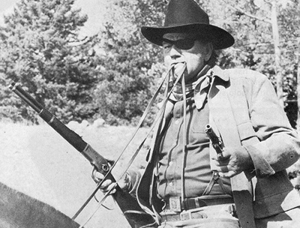
<< The cowboy days are over for the recreational shooting of feral animals in NSW. A damning exposé of what the hunting regulator, the Game Council of NSW, has been up to over the past decade- written by a senior public servant who grew up in rural England, familiar with gun safety – makes astonishing reading.
Steve Dunn describes a politically untouchable posse of gun wielding vigilantes, who enthusiastically set themselves the goal of stopping illegal hunting – despite this actually being the job of police. Dunn says the Game Council was acting beyond its statutory role, and with an inherent conflict of interest. Ultimately they posed an unacceptable risk to the government. The Game Council has now been disbanded by the O’Farrell government.
Boring paper pushing, policy making, analytical or investigations skills weren’t seen as important to this bunch of Wild West public servants. The top job prerequisite to become a game council officer was to be a hunter, and to promote hunting.
Left to their own devices by successive ministers, the game council roamed forest frontiers from its head office in Orange, apparently unconcerned about issues of public safety, promoting their own novel concept of ”conservation hunting”, and cloaked from government oversight.
The Game Council’s website last week boasted of a surge of dead animals last financial year: a ”staggering” 1.23 million animals killed on private land by its hunters, and 21,000 shot on public land. And that these figures meant a 70 per cent increase in its key performance indicator.
But Dunn says the council was confused about its role under the Act. It wasn’t supposed to be tallying carcasses, but instead developing plans for hunter safety, public land access, licensing, education, compliance of licensed hunters and research.
The council considered themselves to be outsiders to other government agencies, who reported the renegades to be combative, assertive, and too aligned with the interests of the hunters they were supposed to be regulating.
The review described a pariah that no other government department could love. If agencies are generally organised into clusters, with small agencies needing both a parent and siblings to survive, the game council was an orphan.
”The Game Gouncil has no parent and no siblings, no one wants to adopt it, and no one really wants a close relationship with it – because of politics,” Dunn wrote.
Established in 2002 under the Labor government, the council had its roots ”deeply embedded in politics”, and arose because of the importance of the Shooters & Fishers Party to the government of the day in the upper house when governments needed to get legislation passed.
.
The council complained it had an image problem in the wider community. But Dunn’s report considers it was a problem of the council’s own making.
.
Carrying private firearms in agency vehicles and hunting on the job are not a good look for public servants. Was it appropriate for the hunting regulator to be handing out promotional stress balls that say ”Stressed? Go conservation hunting”?
In the fallout from the Dunn Review, the Game Council’s regulatory, enforcement, licensing and policy roles have now been transferred to the department of primary industries. A separate advisory Game Board will be formed to represent hunters and advocate hunting.
As the government prepares to allow licensed volunteer shooters to be involved in supervised National Parks and Wildlife Service culls of feral animals in 12 national parks in October, the cowboys that once reigned are out. Strict guidelines for the culls, which will only be held when parks are closed to the public, stipulate: no night shooting, no dogs, no bows and arrows – and no shooting from horses. >>
.
[Source: ‘Cowboy shooters are finished in NSW’, 20130707, by Kirtsy Needham, Illawarra Mercury newspaper, ^ http://www.illawarramercury.com.au/story/1621471/cowboy-shooters-are-finished-in-nsw/]
.
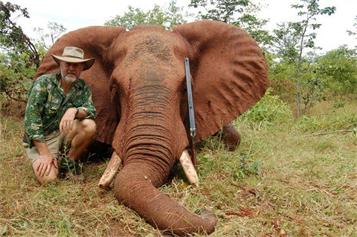 Shooters Party, Robert Borsak with his Big Game kill
~ an African Bull elephant shot on safari in Zimbabwe in June 2008.
[Source: ABC Four Corners, ^http://www.abc.net.au/news/2013-06-11/nsw-mp-robert-borsak-with-an-elephant-shot-on/4745476] Shooters Party, Robert Borsak with his Big Game kill
~ an African Bull elephant shot on safari in Zimbabwe in June 2008.
[Source: ABC Four Corners, ^http://www.abc.net.au/news/2013-06-11/nsw-mp-robert-borsak-with-an-elephant-shot-on/4745476]
.
<< New South Wales Shooters MP Robert Borsak says there has been a culture war over gun control in Australia since the Port Arthur massacre, but he believes people are starting to “get over it.” Mr Borsak believes semi automatic weapons, which were banned in the wake of the 1996 massacre, should be put back in the hands of hunters and recreational shooters. >>
[Source: ‘NSW Shooters MP Robert Borsak says people are ‘getting over’ the Port Arthur massacre’, ^http://www.byronevents.net/nohunting/index.html]
.
.
Further Reading:
.
[1] The Dunn Report (The Governance Review of the Game Council of NSW by Steve Dunn of Independent Consulting, 14th June 2013)
.
ABC Four Corners, ^http://www.abc.net.au/news/2013-06-11/interview-with-robert-borsak-nsw-shooters-and/4745720
.
^http://www.abc.net.au/news/2013-06-11/nsw-mp-robert-borsak-with-an-elephant-shot-on/4745476
.
^http://www.abc.net.au/news/2013-06-11/shooters-mp-says-people-27getting-over27-port-arthur/4745472
.
^ABC, 20130715, ^http://www.abc.net.au/pm/content/2013/s3803487.htm
.
ABC, 20130720, ^http://www.abc.net.au/site-archive/rural/sa/content/2013/02/s3693724.htm
.
‘The Hunting Party’, 20130610, ABC,^http://www.abc.net.au/4corners/stories/2013/06/10/3776198.htm
.
A controversial plan to allow hunting in 79 national parks including the Paroo-Darling National Park in far west NSW near White Cliffs has been delayed indefinitely, 20130220, ABC, ^http://www.abc.net.au/local/audio/2013/02/20/3694440.htm
.
Tags: Game Council NSW, Greater Blue Mountains World Heritage Area, hunting in national parks, Kangaroo shot, Kosciuszko National Park, national parks, NSW Government, poachers, Shooters and Fishers Party, Shooters Party MP Robert Borsak, shooting in national parks, The Dunn Report, weekend warriors, wildlife poaching
Posted in Australian Alps (AU), Blue Mountains (AU), Kangaroos and Macropods, Threats from Poaching and Poisoning | No Comments »
Add this post to Del.icio.us - Digg
Thursday, May 16th, 2013
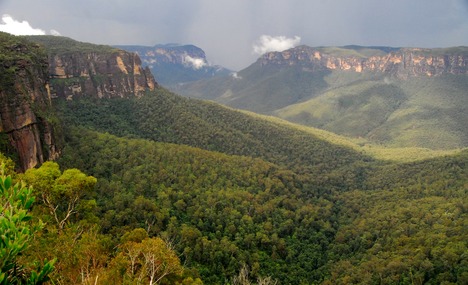 Grose Valley inside the Blue Mountains National Park (World Heritage) Grose Valley inside the Blue Mountains National Park (World Heritage)
before the Parks Service let a fire burn through it out of control
in the Spring of 2006
[Photo by Ian D Smith]
.
20 Sep 2006: (2 months prior) Parks Service maximises hazard reduction burns
.
<<With warmer days just around the corner and continuing dry weather the Blue Mountains Region National Parks and Wildlife Service (Parks Service) is again undertaking rigorous preparation for the coming fire season.
“Every year around this time the Parks Service runs a number of fire preparedness days to ensure staff and fire-fighting equipment are fully prepared for the season ahead”, said Minister for the Environment Mr Bob Debus.
“Fire preparedness days require fire-fighting staff to check their personal protective equipment, inspect fire-fighting pumps and vehicles and ensure that communication equipment and procedures are in place and working before the fire season begins.”
Mr Debus said a number of exercises, including four-wheel drive and tanker driving, first aid scenarios, entrapment and burnovers, were also employed to re-familiarise staff with all apsects of fighting fires.
“Burnovers, where fire-fighters are trapped in a vehicle as fire passes over it, is one of the worst case scenarios a fire fighter can face so pre-season practice is critical to ensure that their response is second nature”, he said.
“Local fire-fighters have also undergone stringent fitness assessments to make sure they are prepared for the physical demands of fire-fighting – like being winched from a helicopter into remote areas with heavy equipment, to work longs hours under very hot and dry conditions wearing considerable layers of protective clothing”, Mr Debus explained.
Mr Debus said that fire preparedness and fitness assessment days worked in conjunction with a number of other initiatives as part of a year-long readiness campaign for the approaching summer.
.
“Over the past 12 months, NPWS officers have conducted more than 150 hazard reduction burns on national park land across NSW. Nineteen hazard reduction burns have been conducted in the Blue Mountains region covered more than 4500 hectares.” said Debus.
.
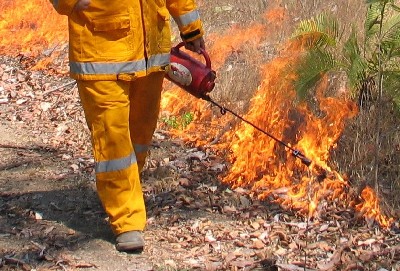 Setting fire to bushland starts bushfires, strangely enough Setting fire to bushland starts bushfires, strangely enough
.
[Ed: These did nothing to prevent the Grose Fires. In fact it was one of the hazard reduction burns deliberately ignited by the Parks Service with the Hartley Vale Rural Fire Service along Hartley Vale Road that escaped over the Darling Causeway that was the main cause of the Grose Fire]
.
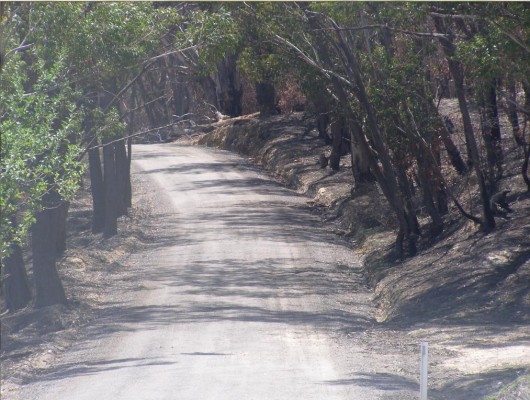 Hartley Vale Road looking east about 1km west of the village of Hartley Vale.
Observe the right (south side) and the consistent blackened ground and blackened tree bases, clear evidence of ground level hazard reduction /backburning.
Compare this to the left unburnt side. It was this Hazard Reduction/Backburn on Sunday 12th November 2006 (or thereabouts) that escaped control and incinerated the treetops up slope and which crossed over the Darling Causeway into the Blue Mountains National Park and ultimately down into the Grose Valley on 23rd November 2006.
[Photo by Editor, 20070204, Photo © under ^Creative Commons] Hartley Vale Road looking east about 1km west of the village of Hartley Vale.
Observe the right (south side) and the consistent blackened ground and blackened tree bases, clear evidence of ground level hazard reduction /backburning.
Compare this to the left unburnt side. It was this Hazard Reduction/Backburn on Sunday 12th November 2006 (or thereabouts) that escaped control and incinerated the treetops up slope and which crossed over the Darling Causeway into the Blue Mountains National Park and ultimately down into the Grose Valley on 23rd November 2006.
[Photo by Editor, 20070204, Photo © under ^Creative Commons]
.
Mr Debus said that while fire fighting authorities are preparing themselves to be ready as possible for flare ups and major fires, home-owners in fire-prone areas of the Blue Mountains should also be readying themselves for the approaching season. [Ed: Famous last words]
“Now is the time to start cleaning gutters, ember-proof houses and sheds, prepare fire breaks and clear grass and fuel away from structures.” he said. [Ed: Such was the least of the bushfire risks when the Parks Service and RFS were actively and recklessly setting fire to bushland].
.
[Source: ‘Fire Crews Prepare’, 20060920, Blue Mountains Gazette, print]
.
Tags: Blue Mountains National Park, Blue Mountains World Heritage Area, bushfire causes, Darling Causeway, Escaped Controlled Burn, Grose Valley Fires 2006, Hartley Vale Road, hazard reduction, national parks, NPWS, prescribed burning
Posted in Blue Mountains (AU), Threats from Bushfire | No Comments »
Add this post to Del.icio.us - Digg
Wednesday, January 2nd, 2013
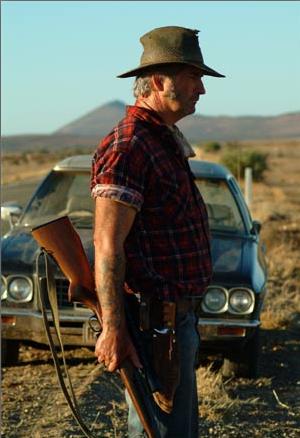
“Now Lizzy… A rifle in the wrong hands can be you know, really dangerous.“
[Character, Mick Taylor, in the 2005 Australian film, Wolf Creek, co-produced and directed by Greg McLean]
.
“Fiction reveals truth that reality obscures“
~ Ralph Waldo Emerson (1803-1882)
.
Strange Truths of the NSW Game Council
.
- Established in 2002 under the Game and Feral Animal Control Act 2002 introduced by the Carr Labor Government
- Annual budget of $3.8 million, of which $2.5 million comes directly from New South Wales taxpayers
- Received more than $12 million in NSW Government funding since 2002, including $2.7 million in 2011, despite NSW Government promises that it would become self-funded
- 16,000 recreational amateur hunters are registered with the Game Council of NSW
- Licenses amateur hunters to use firearms, dogs, and bows to hunt in 400 State forests and Crown land areas
- In the 12 months to 30 April 2012 the Council estimated licensed hunters took 15,663 animals, mostly rabbits, from public land. This represents a public expenditure of $159 per feral animal killed on public lands. [Ed: Imported Gourmet Farmed Cervena New Zealand Red Venison Striploin retails for a premium of AUD$108 per kilo, so $159 for a feral rabbit is far from ‘economical hunting’]
- Since being established there has not been any assessment of the effectiveness of recreational hunting in controlling feral animals in a single State Forest.
- It head Daniel Boon man has been found to have trophy hunted an endangered African elephant for sport and personal gratification
- The NSW Game Council is a political minority interest group that has become a law unto itself
- The political wing of the NSW Game Council is the NSW State Shooters and Fishers Party (perhaps as Sinn Fein is to the IRA).
- In May 2009, Robert Brown MP of the Shooters Party lobbies for the Game and Feral Animal Control Amendment Bill 2009 to be passed into legislation in New South Wales, so that many of Australia’s native fauna across NSW (including National Parks) would be condemned as ‘game animals’ just like in colonial times. The Bill is rejected.
- In June 2010, NSW State Shooters and Fishers Party MP Roy Smith, dies suddenly aged 56, and is replaced by wildlife trophy hunter, Robert Borsak, holding the balance of power in the NSW Upper House.
- In April 2011, The Shooters and Fishers Party presents its “shopping list” of ‘game demands’ to the freshly elected O’Farrell NSW Liberal Coalition Government, in return for the Party’s legislative support in the Upper House. Demands include introducing recreational shooting in NSW national parks and for shooting to be encouraged as a school sport (Columbine, Virginia Tech, Dunblane and Sandy Hook aside).
- In June 2011, sure enough, with the Shooters Party’s supporting O’Farrell’s public sector wages cuts, the government has opened up more than 140 State Forests for recreational hunting for an unprecedented 10 years.
- In July 2011 Shooters’ Party proposes its Firearms Amendment Bill 2011 to allow firearms and ammunition in National Parks, children to have ready access to air rifles without a need for a permit, allows a person to own purchase air rifles without restrictions, and to ease safety regulations on shooting clubs and firearms sellers. The Bill is rejected.
- In June 2012, the O’Farrell Government does another deal with the Shooters Party allow shooting in national parks and other reserves, in exchange for support for State energy privatisation support. Amendments are made to the Game and Feral Animal Control Act 2002.
- In November 2012, the O’Farrell Government does another deal with the Shooters Party to allow duck shooting licences in return for their support to privatise two major ports. Now the power over issuing duck shooting licences shifts from the National Parks and Wildlife Service to the pro-hunting Games Council. Amendments are made to the Game and Feral Animal Control Act 2002 and the National Parks and Wildlife Act 1974. This is one step short of reintroducing Open Season Duck Hunting in NSW, long banned by the Carr Government in 1995.
- In September 2012, illegal shooting of kangaroos in the Deua National Park camp is reported, which was subsequently verified by the Office of Environment and Heritage which reported: “After it was reported to the National Parks and Wildlife Service, the investigating park Ranger sighted two kangaroos that had been shot. One animal was euthanised. The matter is under investigation by NPWS and NSW Police.”
- Recently, the Shooters and Fishers Party announced that they plan to introduce legislation to repeal the Native Vegetation Act 2003, the law that controls broadscale land clearing and regulates logging activities on private land.
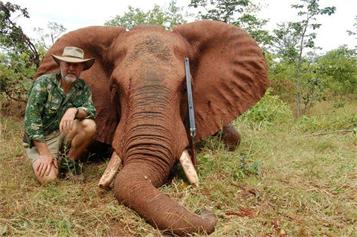 Robert Borsak, NSW Shooters & Fishers Party Robert Borsak, NSW Shooters & Fishers Party
.
“Hunting is ingrained in human consciousness and genetics by at least 1.5 million years of evolution, according to the latest scientific evidence, and in the modern perspective, fishing is one of the nation’s most popular pursuits.” ~ Robert Borsak – NSW Shooters & Fishers Party, 2012.
.
.
“I never wonder to see men wicked, but I often wonder to see them not ashamed.”
.
~ Jonathan Swift (1667-1745)
 Those who corrupt the public mind are just as evil as those who steal from the public purse.
~ Stevenson, Adlai E.
.
<<We went into a camp to inoculate some children. We left the camp after we had inoculated the children for polio, and this old man came running after us and he was crying. He couldn’t see. We went back there, and they had come and hacked off every inoculated arm.
There they were in a pile. A pile of little arms. And I remember… I… I… I cried, I wept like some grandmother. I wanted to tear my teeth out; I didn’t know what I wanted to do! And I want to remember it. I never want to forget it… I never want to forget. And then I realized… like I was shot… like I was shot with a diamond… a diamond bullet right through my forehead. And I thought, my God… the genius of that! The genius! The will to do that!
Perfect, genuine, complete, crystalline, pure. And then I realized they were stronger than we, because they could stand that these were not monsters, these were men… trained cadres. These men who fought with their hearts, who had families, who had children, who were filled with love… but they had the strength… the strength… to do that.
If I had ten divisions of those men, our troubles here would be over very quickly. You have to have men who are moral… and at the same time who are able to utilize their primordial instincts to kill without feeling… without passion… without judgment… without judgment! Because it’s judgment that defeats us.>>
[Quote from character Colonel Walter E. Kurtz out of the epic Vietnam War film Apocalypse Now of 1979, directed by Frances Ford Coppola. Watch extract: ^http://www.youtube.com/watch?v=KxLFdJLSho8]
.
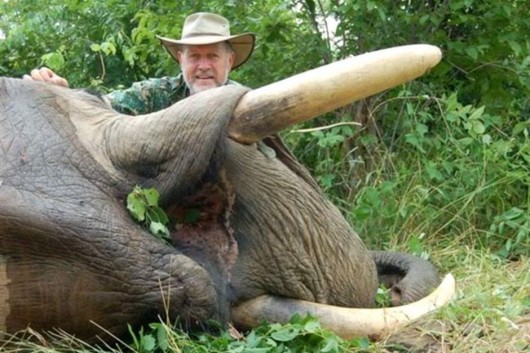 “The joy of killing! The joy of seeing killing done – these are traits of the human race at large.” “The joy of killing! The joy of seeing killing done – these are traits of the human race at large.”
~ Mark Twain, ‘Following the Equator: A Journey Around the World’ (1897), American Publishing Co., Hartford.
.
Tags: Borsak the Wicked, Deua National Park, Firearms Amendment Bill 2011, Game and Feral Animal Control Act 2002, national parks, National Parks and Wildlife Act 1974, Native Vegetation Act 2003, NSW Game Council, NSW Government, NSW Shooters & Fishers Party, O'Farrell, public purse, Robert Borsak, Strange Truths, weekend warriors
Posted in Threats from Poaching and Poisoning | No Comments »
Add this post to Del.icio.us - Digg
Thursday, September 13th, 2012
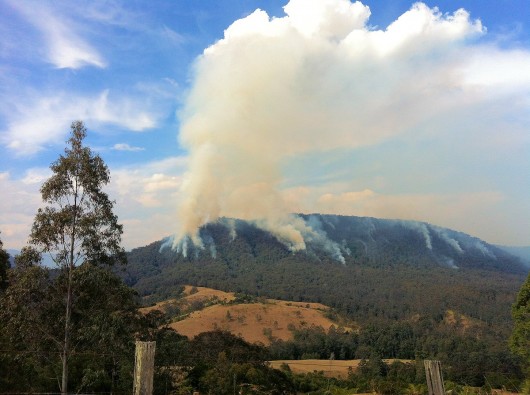 NSW National Parks and Wildlife Service setting fire to native habitat while the weather is calm.
What fauna, it’s an ‘Ecological Burn’?
This week’s hazard reduction burn in Barrington Tops NP, north of Dungog
[Source: Photo by Andy Boleyn, ^http://newcastleonhunter.com/2012/08/npws-burning-down-the-tops/] NSW National Parks and Wildlife Service setting fire to native habitat while the weather is calm.
What fauna, it’s an ‘Ecological Burn’?
This week’s hazard reduction burn in Barrington Tops NP, north of Dungog
[Source: Photo by Andy Boleyn, ^http://newcastleonhunter.com/2012/08/npws-burning-down-the-tops/]
.
It’s that time of year across Australia, when bush arson is deemed acceptable (even noble) , so long as it is ‘prescribed‘ by government, even when it often gets out of control.
Australia’s native habitat is deliberately set fire to by Australian Government agencies every year, just in case it burns, which means that frequently they can’t put it out.
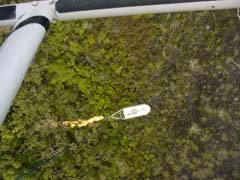 Dropping petrol bombs by immoral helicopter pilots Dropping petrol bombs by immoral helicopter pilots
..”hey man, this is like Nam all over again!”
.
None of the arson rationale respects native wildlife, as with illegal bush arsonists. There is little difference on wildlife impact as to who sets fire to their habitat – illegal or government sanctioned. In the above burn, Acting NPWS Barrington Tops Area Manager Peter Beard, justifies setting fire to wildlife habitat thus:
.
“Hazard reduction burn aims to protect lives and property, whilst maintaining the biodiversity of the World Heritage-listed park.”
.
Yet it is carried out without any thought or knowledge about the ecological impacts upon ground dwelling fauna populations or upon flora species that are fire sensitive nor the complex and fragile co-existences. Where are the independent scientific wildlife counts before and after each prescribed arson sortie? Where is the qualified wildlife ecologist’s report that made public that says burning this forest is not harmful?
The fire lighting is not even mosaic. It is blanket, broadscale and indiscriminate. Aerial incendiaries are dropped along the ridge top by helicopter casuing multiple ignition points so that the fire takes hold.
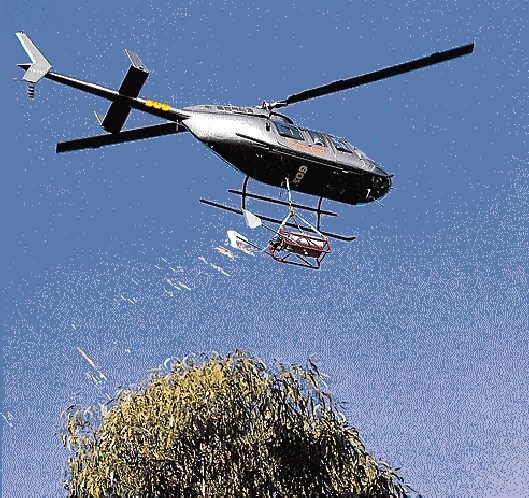 Aerial ‘habitat reduction’ occurs across National Parks and World Heritage Areas
– no habitat is sacrosanct.
It is euphemistically branded ‘Biodiversity Burning’ – fire is good for wildlife – watch them run, watch the Echinas and Wombats burn! Aerial ‘habitat reduction’ occurs across National Parks and World Heritage Areas
– no habitat is sacrosanct.
It is euphemistically branded ‘Biodiversity Burning’ – fire is good for wildlife – watch them run, watch the Echinas and Wombats burn!
.
It is one of many hundred being conducted across New South Wales native landscapes by the National Parks and Wildlife Services as well as by the Rural Fires Service and with assistance from regional fire brigades. Another 25 burns covering 6000ha are planned in the next week, including burns in In Ku-ring-gai Chase National Park and the Blue Mountains World Heritage Area.
Rather through unrelenting government propaganda, all Australian native vegetation is demonised as a ‘threat‘, a ‘hazard‘ and as ‘fuel‘ – just like the Christian church has for centuries demonised non-believers as heathens.
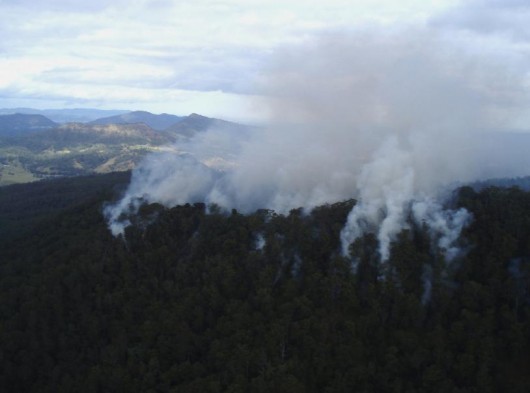 National Parks are deemed by Australian governments as a ‘hazards’!
It is a town park mentality – a bit of greenery for people to enjoy at weekends. National Parks are deemed by Australian governments as a ‘hazards’!
It is a town park mentality – a bit of greenery for people to enjoy at weekends.
.
It doesn’t take much effort by a layperson to access a computer, download Google Earth and zoom into New South Wales, then to realise that the native vegetation that remains is dotted in islands within vast landscapes of denuded cleared farmland, and then to respect that if the native wildlife exist anywhere, they are in these vegetation islands.
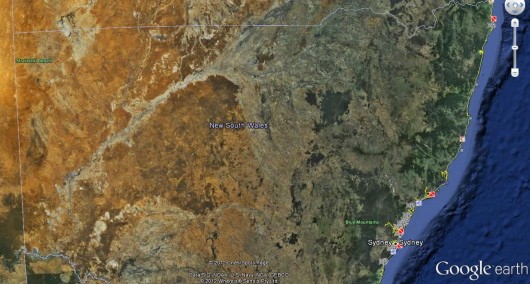 This is Destination New South Wales..
about 90% deforested, or burned, or farmed, or mined, or housed or else deserted This is Destination New South Wales..
about 90% deforested, or burned, or farmed, or mined, or housed or else deserted
‘NSW.. see where it takes you’..enjoy!
[Click image to enlarge, or visit Google Earth’s website]
.
“There are some amazing natural attractions in New South Wales. From the coast to the country you’re spoilt for choice. All over this state you can meander at your own pace and discover a whole world of extraordinary natural wonders. With close to 900 ^NSW national parks, forests and reserves, the State features the most diverse nature experiences in Australia ranging from rainforests, marine parks, a city within a national park, outback landscapes, mountains, islands and World-heritage listed areas.”
[Source: New South Wales Tourism Department, ^http://www.visitnsw.com/things-to-do/nature-and-parks]
.
Then for these islands of native vegetation to be deliberately set fire to can only contribue to native wildlife extinctions. It doesn’t take more than a lay person to realise this by deduction. Yet wildlife extinction is exactly what these senseless fatalistic government bush arson culls are doing every year. Setting fire to wildlife habitat is wildlife desecration, just like an invading army razing a village.
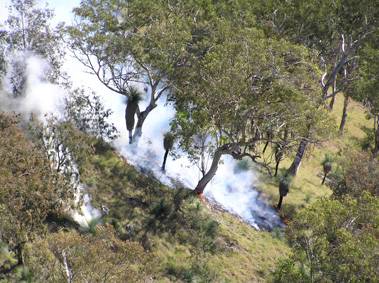
Rural fire agencies throughout Australia are no different in mindset to paid professional urban fire brigades – their mandate is to serve only to protect human life and property – but all native vegetation and wildlife is demonised as a liability and dismissed as only a risk to human life and property. The key distinction between rural fire fighters and their urban counterparts is that the urban fire fighters are paid professionals. Governments save billions by not paying rural firefighters and by not training them to the skill level of urban firefighters – yet operationally their job is exactly the same. Volunteers have been conned by governments to being cheap fingers in the dyke, so that taxes can be channelled elsewhere instead of properly into emergency management.
When there is a wildfire under extreme bushfire weather conditions, the ill-equipped, under=prepared and under-resourced bushfire agenecies know full well, that they cannot reliably detect, reach or suppress ignitions most of the time. They are depressing forced to rely upon the vagrancies of wind changes to dictate the impact of wildfires and the fate to lives and property.
So that is why government is so keen to prescribe preventative fighting fire with fire. If the bush is burned so that there is litte to burn then when a wildfire erupts in hot, dry and windy conditions the risk is less.
.
.. one has to destroy the village to save it!
.
Oddly this mindset is not allowed to apply to plantation forests – because they are deemed ‘economic assets’ and so therefor evaluable and therefore worth protecting from fire.
Of course, after every major fire involving loss of human life, such as in Victoria in 2009, all the politicians come out crying “shocking, shocking, shocking”, promising expensive enquiries, promising more resourcing, and that it will never happen again. All the while, politicians full well know that when the media cameras lose interest, it is cheap volunteer business as usual, because by the time the next wildfire, they will be happily lifestyle pensioned out – polly gold card privileges and all.
The Victorian Bushfires of 2009 that caused the deaths of 173 people were in the main caused initially by either powerline neglect and arson. The fire brigade was not prepared for a catastrophe despite the bushfire danger index forecast days before to be well off the scale. The underprepared, under-resourced Dad’s Army preparedness contributed to the 173 deaths.
Instead, all Australian and State governments have blamed the Australian wildlife habitat for being the fuel like and ‘accessory before the fact’. It was the victim.
So hazard reduction is now ramped up Australia wide. In New South Wales hazard reduction this year is the NSW Government’s response strategy, costing $62 million “to boost wildfire preparedness“. Under the NSW NPWS ‘Enhanced Bushfire Management Programme’, NPWS aims to double the number of hazard reduction hectares each year, for the next five years. NSW Environment Minister Robyn Parker said hazard reduction work is part of an ongoing State-wide operation.
If there is unburnt bush, it will be targeted for burning! Burn it before it burns, god damn! If the Rural Fire Starters had access to B52s and Agent Orange, they sure the would deploy both, such is the inculcated bushphobic mindset.
“NPWS crews are already taking advantage of favourable spring weather to carry out 12 burns covering more than 2,500 hectares of national park in the past fortnight.”
The NSW Government is doing everything it can to reduce the risk of fire, including in our national parks – particularly with a drier, hotter summer than we’ve recently experience predicted.”
[Source: ^http://newcastleonhunter.com/2012/08/npws-burning-down-the-tops/]
.
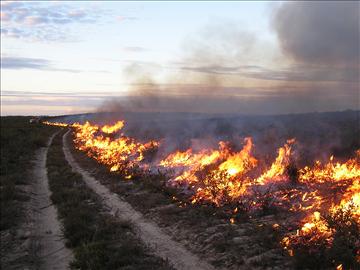 Broadscale Hazard Reduction
‘So when summer comes we should be right – there’ll be nothing left to burn!’
‘Job Done!‘ Broadscale Hazard Reduction
‘So when summer comes we should be right – there’ll be nothing left to burn!’
‘Job Done!‘
.
It is a wicked species-anhilating strategy that most in the broader community ignorantly accept as justified, because government propaganda threats say so and because few folk have the wisdom or courage to dare question the propaganda.
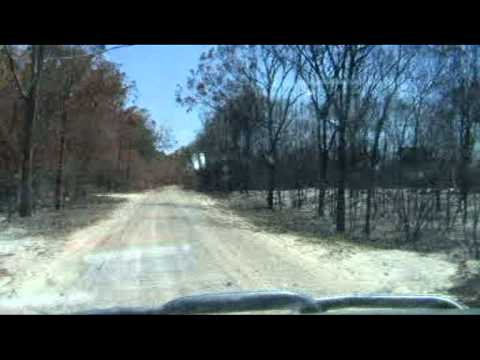 Woops, the prescribed burn got out of control
That’s ok its only Fraser Island World Heritage – it’ll grow back! Woops, the prescribed burn got out of control
That’s ok its only Fraser Island World Heritage – it’ll grow back!
.
Last weekend, a 12-year-old boy was charged with lighting a bushfire at Watannobi on the Central Coast around lunch time. Just like the fire fighters he must be watching and learning from, the bushfire was lit using multiple ignition points so that it took hold. Sure enough, the blaze quickly escalated. In the end some eighty hectares of native vegetation and grassland were burnt before the fire was contained in the mid afternoon.
He may be charged now, but no doubt he is recruitment material for the local Rural Fire Starters when he gets older.
But unlike the State-sanctioned arsonists, the boy was publicly apologetic for what he had done, realising that it was wrong. To his credit he said:
.
“I’m sorry for what I have done .. and I won’t do it again.”
.
[Source: ‘Boy apologises for lighting F3 Fire’, Seven News (Sydney television), 20120911, ^http://au.news.yahoo.com/video/national/watch/30549030/boy-apologises-for-lighting-f3-fire/]
.
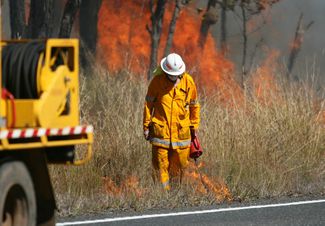 Government-sanctioned arsonists know what they are doing is wrong
– but the Firie peer pressure is too great Government-sanctioned arsonists know what they are doing is wrong
– but the Firie peer pressure is too great
.
Why don’t gardeners of Australian native gardens follow the National Parks biodiversity burning mantra and set fire to their gardens? Because they respect the unburnt value of Australia’s flora.
.
Why do we not see much wildlife anymore in National Parks?
.
Wednesday, September 5th, 2012
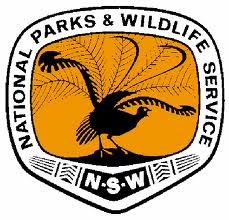 ‘National Parks’ in Australia are merely State Parks
They exist at the whim of State politicians ‘National Parks’ in Australia are merely State Parks
They exist at the whim of State politicians
.
In Australia, ‘National Parks‘ are a misnomer.
National Parks across Australia are not protected, conserved and managed by the Australian Government at national level, as the name would suggest. Instead, the custodial responsibility is delegated to the respective States.
National parks in each Australian State, such as in New South Wales, or Queensland or Tasmania, are protected, conserved and managed under that State’s national parks legislation, not under national legislation. So in Australia, the term ‘National Park‘ is quite misleading. Australians presume that our national parks are nationally protected, but they are not.
The respective ‘National Parks and Wildlife Services‘ are similarly also a misnomer. Each State and Territory has its own separate National Parks and Wildlife Service. In New South Wales (NSW), ‘national parks’ are managed by the NSW National Parks and Wildlife Service. In Tasmania, the State-controlled Parks and Wildlife Service manages national parks only in Tasmania.
In Victoria, the State-based agency is called Parks Victoria, which manages national parks in Victoria under Victorian legislation – the Parks Victoria Act 1998 and reports to the Victorian Minister for Environment and Climate Change. While in Queensland, the Queensland Parks and Wildlife Service comes under the Department of National Parks, Recreation, Sport and Racing.
When a government lumps national parks with racing, it regards the values of natural heritage in anthropocentric exploitative terms.
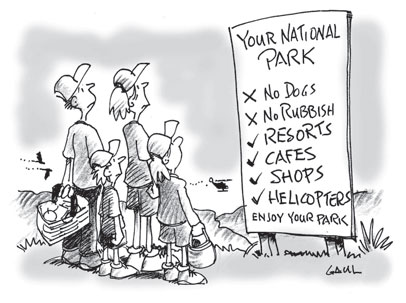 . .
Neglectful Underfunding
.
Worse is that the delegated State Government custodians are invariably so short of funding, that critical funding to properly protect, control and manage national parks is not provided. The Australian Government knows this, yet withholds vital funding so that the primary duties of protecting and conserving national parks can be fundamentally fulfilled.
State Governments select other funding priorities according to election cycles. In the 2012-13 budget year, the NSW Government has cut $55 million in recurrent funding and $22 million in capital expenditure budget in its management of national parks and to help protect native fauna. [Source: ‘NSW environment suffers $77m budget cut’, Jun 12 2012, ^http://news.ninemsn.com.au/national/8482272/nsw-environment-suffers-77m-budget-cut]
In Queensland, the State Government in 2012 has not only removed one hundred jobs from the Queensland Parks and Wildlife Service, closed regional offices, and reduced the number of QPWS regions from nine to six, but plans to revoke 875,000 hectares of national parks land across the State. [Source: ‘LNP Government: Mean To Students, Tricky On National Parks’, by Annastacia Palaszczuk, 20120719, ^http://www.queenslandlabor.org/2012/07/19/lnp-government-mean-to-students-tricky-on-national-parks/]
In Victoria in 2012, more than 130 jobs have been cut from Parks Victoria and several hundred from the Department of Sustainability and Environment (DSE). [Source: ‘Jobs and courses feel Budget strain’, by Kate Dowler, Weekly Times Now, 20120509, ^http://www.weeklytimesnow.com.au/article/2012/05/09/479741_national-news.html]
Last Easter in April 2012, some state and national parks are facing industrial action by Parks Victoria rangers belonging to the Community and Public Sector Union.
‘On the surface this may appear to be a simple wage dispute, but in fact it’s just a symptom of a larger and much more serious disease. It’s no secret that Parks Victoria is suffering from chronic underfunding. Parks and reserves across Victoria are seeing the results of decades of government cut-backs. These funding cuts affect our parks and reserves in many ways. From the supply of basic amenities (such as toilet rolls), all the way to establishing and maintaining user facilities such as walking and mountain bike trails as well as creating new management and environmental plans for the future. Looking after our public spaces is, quite simply, a massive job and if it is to be done correctly it will require substantial government funding.
Many Parks Victoria rangers do an amazing job in increasingly difficult circumstances. One of my ranger friends commented that ‘productivity improvements’ was in fact government speak for ‘saving money’. [Source: ‘Parks Victoria: Death By a Thousand Cuts’, by lenn Tempest, April 6, 2012, ^http://osp.com.au/?p=3253]
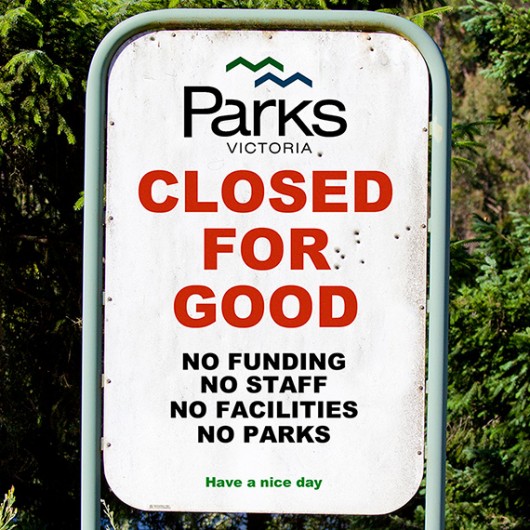
.
Belittling the National Parks Status
.
Just as bad is that the role of National Parks and Wildlife Service at each State jurisdiction has become swallowed up within mega-departmental portfolios. Australia used to have dedicated ministers for environment. Environment was their sole responsibility and national parks featured as a key part of that responsibility. But over recent decades, all the state governments have seen fit to bundle the responsibility for national parks within a large range of disparate portfolio responsibilities to one government minister.
In Tasmania, national parks responsibility falls under the responsibility of the Department of Primary Industries, Parks, Water and Environment – tagged on at the end. The current minister responsible is Brian Wightman MP, who is also Minister for Environment, Parks and Heritage (a different department name) and simultaneously Minister for Justice. How much time and energy can Wightman dedicate to national parks in his working week?
In New South Wales, the NSW National Parks and Wildlife Service (NPWS) is part of the Office of Environment and Heritage (OEH), within the NSW Department of Premier and Cabinet. The delegated minister is Robyn Parker MP who is the Minister for the Environment and the Minister for Heritage. These functions are relatively compatible, yet only a few years prior under the previous government, NPWS came under the Department of Environment, Climate Change and Water, and the various ministers responsible for varying short stints, also had other unrelated yet demanding portfolios such Commerce and Health.
In Queensland, Steven Dickson MP is responsible for National Parks, Recreation, Sport and Racing. In Victoria, Parks Victoria is lumped in with the Department of Sustainability and Environment, Catchment Management Authorities, Commissioner for Environmental Sustainability, Environment Protection Authority Victoria, Landcare Victoria, Sustainability Victoria and Zoos Victoria, which all report to Ryan Smith MP is Minister for Environment and Climate Change as well as being Minister for Youth Affairs. How many minutes does Smith give Parks Victoria in a given week?
The extreme bundling of so many responsibilities with the national parks function, effectively belittles its role.
The dilution of the national parks role is compounded by the trend of the short term assignment of a given minister to the portfolio, even within the one term of government, let alone when governments change hands. And where is the ultimate guardian for Australia’s national parks in all this – wiping its hands of responsibility and accountability for Australia’s most precious ecological assets.
Further, one can think of no minister for the environment who has ever had formal training or qualifications in environmental scence, or having been a National Parks ranger. The ultimate responsibilities for environment are delegated to politicians with little or no understanding of managing the natural environment, with all its complexities. In New South Wales the current Minister for Environment and Heritage is qualified in child day care.
.

.
World Heritage managed at State Level
.
State delegation of national parks even applies to national parks in Australia that have been listed as World Heritage Areas, like the Blue Mountains National Park, Fraser Island National Park, Great Barrier Reef National Park, Kakadu National Park, and Tasmanian Wilderness. While the Australian Government has an international obligation to protect and conserve World Heritage properties, those World Heritage properties do not become Australian Commonwealth property. State and local laws still apply. The only protection afforded to World Heritage properties is that land uses must not threaten any of the outstanding universal values of the property.
World Heritage listed properties in Australia are supposed to be managed by the Australian Government under obligations that the Australian Government signs up to under the World Heritage Convention for each listed property.
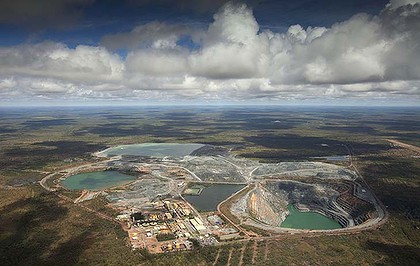 Rio Tinto’s Ranger uranium mine inside Kakadu World Heritage, Northern Territory
[Source: ‘Radioactive threat looms in Kakadu’, 20110416, by Lindsay Murdoch, Jabiru, Sydney Morning Herald,
^http://www.smh.com.au/environment/radioactive-threat-looms-in-kakadu-20110415-1dhvw.html] Rio Tinto’s Ranger uranium mine inside Kakadu World Heritage, Northern Territory
[Source: ‘Radioactive threat looms in Kakadu’, 20110416, by Lindsay Murdoch, Jabiru, Sydney Morning Herald,
^http://www.smh.com.au/environment/radioactive-threat-looms-in-kakadu-20110415-1dhvw.html]
.
The management objectives for World Heritage properties are part of Australia’s general obligations under the World Heritage Convention, which primarily includes protecting and conserving the World Heritage values of the given World Heritage property. However, the Australian Government chooses to achieve this objective by what it describes as “recognising the role of current management agencies in the protection of a property’s values” (that is by government agencies in their respective States), but also delegating custodial responsibility to the local community “in the planning and management of a World Heritage property.
In doing so, the Australian Government wipes its hands of its signed up custodial responsibility to protect and conserve Australia’s World Heritage listed properties. This is most evident with the Queensland Government currently allowing dredging in Gladstone Harbour within the Great Barrier Reef World Heritage. It is also most evident with the Tasmanian Government allowing clearfell logging adjacent to the Tasmanian Wilderness World Heritage.
The Australian Government is also liberal with its interpretation of protecting and conserving World Heritage values by what it describes as “allowing provision for use of the property which does not have a significant impact on the World Heritage values and their integrity.”
[Source: ‘Management of Australia’s world heritage listed places’, Australian Government, Department of Environment etc (currently called the Department of Sustainability, Environment, Water, Population and Community, ^http://www.environment.gov.au/heritage/about/world/managing.html]
.
‘We have become, by the power of a glorious evolutionary accident called intelligence, the stewards of life’s continuity on earth. We did not ask for this role, but we cannot abjure it. We may not be suited to it, but here we are.’
~ Steven Jay Gould, paleontologist
.
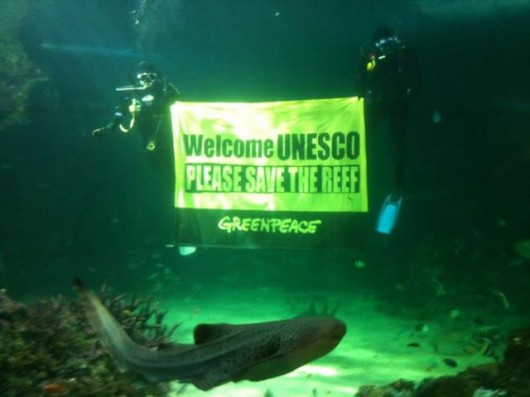 Industrialisation of the Great Barrier Reef
The dredging in Gladstone Harbour for the seam gas has been blamed by local environmentalists for the area’s poor water quality
and a skin disease affecting marine life. Green activists say dredging has adversely affected whales and dugongs in the area.
[Source: Queensland slams UNESCO, defends gas on the barrier reef Industrialisation of the Great Barrier Reef
The dredging in Gladstone Harbour for the seam gas has been blamed by local environmentalists for the area’s poor water quality
and a skin disease affecting marine life. Green activists say dredging has adversely affected whales and dugongs in the area.
[Source: Queensland slams UNESCO, defends gas on the barrier reef
Posted on June 5, 2012, ^http://rowenadelarosayoon.wordpress.com/2012/06/]
.
Tags: Australian Government, Gladstone Harbour, Great Barrier Reef World Heritage, Industrialisation of the Great Barrier Reef, Kakadu mining, national parks, National Parks and Wildlife Service, National Parks Status, World Heritage, World Heritage cons, World Heritage Convention obligations
Posted in Threats from Government Funding Neglect | 2 Comments »
Add this post to Del.icio.us - Digg
Saturday, December 3rd, 2011
This article was initially published by Tigerquoll 20090622 onCanDoBetter.net under the article title ‘Rees’ ‘red hot go’ hunting in our National Parks‘. It has been modified somewhat.
.
New South Wales Premier Rees is set to pass into law a ‘Game and Feral Animal Control Amendment Bill 2009‘ to permit recreational hunters shooting everything and anything in protected National Parks across NSW, including native wildlife.
Controlling feral animals is a science, not a sport. Rees’ passion for sport is compromised by influential cronies and naivety. Problem is: Rees has no knowledge, experience in or aptitude for science. His inaugural “red hot go” says it all and threatens to be his legacy.
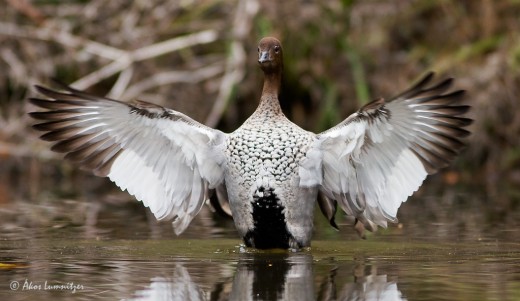 Australian Wood Duck (Chenonetta jubata) Australian Wood Duck (Chenonetta jubata)
(a native species not protected)
©Photo by Ákos Lumnitzer (with permission), ^http://www.amatteroflight.com/
.
Be clear, the Game and Feral Animal Control Amendment Bill 2009, Schedule 3, Part 2 lists the following Australian native fauna as free ‘game‘, including:
.
Native Ducks:
Australian Shelduck (or Mountain Duck) (Tadorna tadornoides)
Australian Wood Duck (or Maned Duck) (Chenonetta jubata)
Black Duck (or Pacific Black Duck) (Anas superciliosa)
Blue-winged Shoveler (or Australasian Shoveler) (Anas rhynchotis)
Chestnut Teal (Anas castanea)
Grass Duck (or Plumed Whistling Duck) (Dendrocygna eytoni)
Grey Teal (Anas gibberifrons)
Hardhead Duck (or White-eyed Duck) (Aythya australia)
Pink-eared Duck (Malacorhynchus membranaceus)
Water Whistling Duck (or Wandering Whistling Duck, Whistling or Wandering Tree Duck) (Dendrocygna arcuata)
Native Quails:
Brown Quail (Coturnix ypsilophora)
Stubble Quail (Coturnix pectoralis)
Native Birds:
Australian White Ibis (Threskiornis molucca)
Black Swan (Cygnus atratus)
Common Bronzewing Pigeon (Phaps chalcoptera)
Galah (Eolophus roseicapilla)
Little Corella (Cacatua sanguinea)
Long-billed Corella (Cacatua tenuirostris)
Purple Swamphen (Porphyrio porphyrio)
Straw Necked Ibis (Threskiornis spinicollis)
Sulphur Crested Cockatoo (Cacatua galerita)
Topknot Pigeon (Lopholaimus antarcticus)
Kangaroos:
Eastern Grey Kangaroo (Macropus giganteus)
Euro (Macropus robustus)
Red Kangaroo (Macropus rufus)
Western Grey Kangaroo (Macropus fuliginosus)
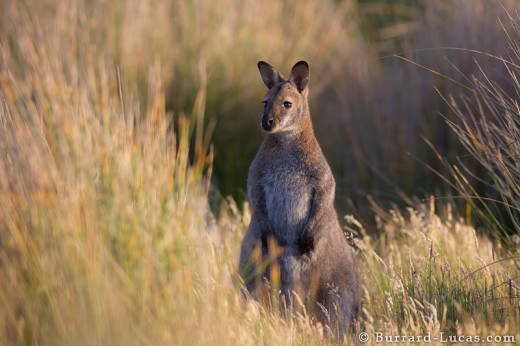 Bennetts Wallaby (Red-Necked Wallaby) (Macropus rufogriseus)
is native to Tasmania, but is not protected
(© Photo Burrard-Lucas) ^http://www.burrard-lucas.com/ Bennetts Wallaby (Red-Necked Wallaby) (Macropus rufogriseus)
is native to Tasmania, but is not protected
(© Photo Burrard-Lucas) ^http://www.burrard-lucas.com/
.
If the proposed legislation is genuinely and solely to control feral animals, the National Parks and Wildlife Service (NPWS) as delegated custodian of National Parks in New South Wales, must first answer these questions:
- Why are native animals included amongst the ferals?
- What action in fact has the NPWS undertaken over the last 20 years to control ferals in National Parks across NSW?
- Which measures have been successful at dealing with the target species and which have not?
- Which measures have caused a detrimental impact on non-target species?
- What interstate or overseas model/case study does NPWS rely upon to justify why shooting is the preferred method of control?
- What standard of identification test is imposed on would be feral shooters?
- What standard of marksmanship is required and what NPWS-approval system would be in place?
- What monitoring is to be conducted of these shooters and by whom?
- What happens to the carcasses to prevent disease?
.
If NPWS was serious about controlling feral animals in National Parks, it would have a permanent programme to specifically deal with the key threatening processes that involve ferals, namely to target:
- Competition and grazing by the feral European rabbit
- Competition and habitat degradation by feral goats
- Environmental degradation caused by feral deer
- Predation by feral cats
- Predation by the European Red Fox
- Predation, habitat degradation, competition and disease transmission by feral pigs.
SOURCE: DEC, ^http://www.threatenedspecies.environment.nsw.gov.au/tsprofile/pas_ktp.aspx
.
These feral species need to be the primary target of eradication. Professional contract shooting may be an option, but it is not for ‘weekend warrriors‘. The solution must be science-based not sport-based.
According to the Australian Wildlife Conservancy:
“Australia has the worst mammal extinction record in the world – 27 mammals have become extinct in the last 200 years. No other country or continent has such a tragic record of mammal extinctions.”
.
.
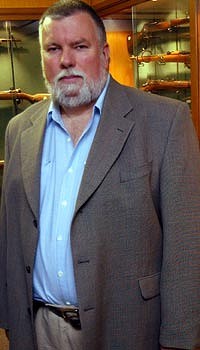 . .
In June 2009 the Game and Feral Animal Control Amendment Bill was introduced into the NSW Upper House by Shooters Party MP Robert Brown, that would pave the way for hunting in national parks, private game reserves, the hunting of native species and the growth of recreational shooting on public and private lands (Sydney Morning Herald, page 6, 12 June 2009). Lee called on the Environment Minister Carmel Tebbutt to reject outright a new bill from the Shooters Party.
.
The NSW Government has withdrawn its support for the bill, but it is still before the NSW Parliament!
.
[Source: Australian Greens Party Senator Lee Rhiannon, ^http://archive.leerhiannon.org.au/portfolios/firearms/firearms/atct_topic_view?b_start:int=10&-C=]
.
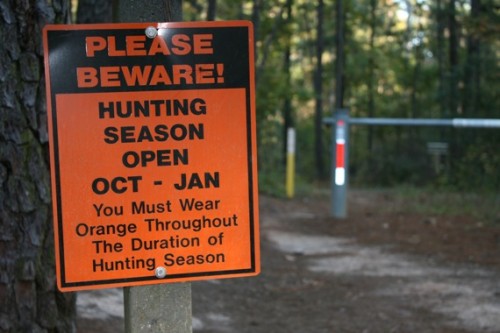
Overview of the Game and Feral Animal Control Amendment Bill 2009:
.
The object of this Bill is to amend the Game and Feral Animal Control Act 2002 (the Act) as follows:
- To enable the Minister responsible for national park estate land to make that land available for the hunting of game animals by licensed game hunters
- To expand the list of game animals that may be hunted in accordance with the Act and, in the case of any native game animals that are listed, to impose special requirements in relation to the hunting of those animals by licensed game hunters
- To provide for the operation of private game reserves under the authority of a licence granted by the (NSW) Game Council
- To make it an offence to approach persons who are lawfully hunting on declared public hunting land or to interfere with persons lawfully hunting game animals
- To make a number of other amendments of an administrative, minor or consequential nature..
.
[Source: ^ http://www.parliament.nsw.gov.au/prod/parlment/nswbills.nsf/1d4800a7a88cc2abca256e9800121f01/6dce0470707e4f4bca2575b4001bd3f1/$FILE/b2009-031-d10-House.pdf]
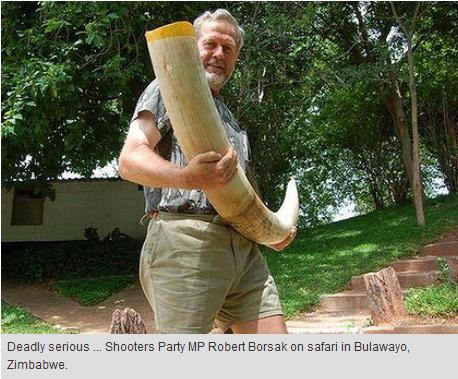
Support from the Coalition of Law Abiding Sporting Shooters Inc (CLASS):
.
‘For too long large areas of bushland has been locked away (aka protected from exploitation) as National Parks, State Forests etc. In many of those parks and forests invasive plants, such as blackberries, bracken, lantana, etc have grown unchecked, resulting in a great unbalance among local flora leading to reduced biodiversity among fauna. Permitting conservation hunting in those areas will help restore the balance, while permitting controlled harvesting of native and introduced species for food, trophies or fur/leather….the Game and Feral Animal Control Amendment Bill 2009 will go a long way to utilising the inherent value of sustainable resources which would otherwise be wasted.’
[Source: ^http://www.c-l-a-s-s.net/game-bill.htm]
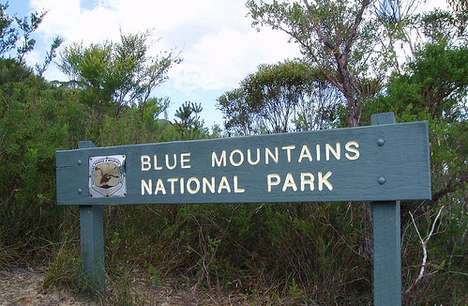 According to CLASS, wildlife in National Parks are wasted resources According to CLASS, wildlife in National Parks are wasted resources
.
.
Selected background articles at the time:

‘Government deal to open national parks to shooters’
.
[Source: Erik Jensen, 20091021, Sydney Morning Herald ^http://www.smh.com.au/environment/conservation/government-deal-to-open-national-parks-to-shooters-20091020-h6yt.html]
.
Hunters will be allowed to shoot animals in national parks for the first time under a deal offered to the Shooters’ Party by the NSW Government. The Herald understands the deal would modify a private member’s bill introduced by a member of the Shooters’ Party, Robert Brown, to allow hunting in 13 national parks if the Shooters’ Party removed demands for enclosed game reserves or safari parks from its draft legislation.
”We have had discussions with senior Labor people,” Mr Brown said. ”I’m not going to confirm or deny that we’re any closer to a resolution … My bottom line is the whole bill must be passed or we continue to withdraw our support for the Government.”
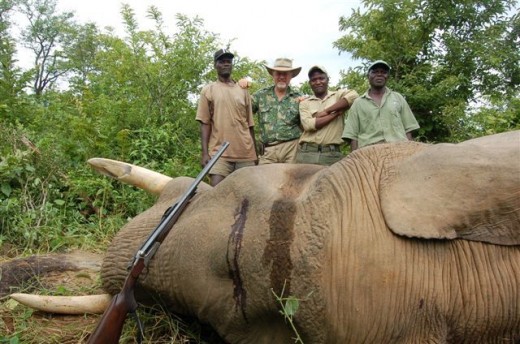
The Shooters’ Party has been holding the Government to ransom since introducing the bill in June and yesterday voted against the Government on all legislation in the upper house. Negotiations on the bill had broken down with the Premier’s chief of staff, Graeme Wedderburn – who Mr Brown described as ”tits on a bull” – but resumed in September, less than a week after John Robertson took over the environment portfolio. The Treasurer, Eric Roozendaal, one of Mr Robertson’s factional allies, took part in negotiations.
According to Mr Brown, the pair offered a memorandum of understanding that would allow hunting in national parks along the Queensland and South Australian borders. But he said the proposed parks were too far away.
”The closest one to Sydney was 10 hours’ drive,” he said. ”That [offer] was there to f— us, as far as I’m concerned.”
The Greens’ spokeswoman on animal welfare, Lee Rhiannon, said the deal was intended to allow free passage of Government legislation through the upper house but may cost Labor seats at the next election – including that of the former environment minister Carmel Tebbutt.
”We’re about to come into the busiest legislation time of the year. They’re going to have to pass 30 bills in a week,” she said. ”If they don’t have the Shooters’ on side, they’ll actually have to talk to other people. [But] as well as being ethically wrong and environmentally damaging, they will be inflicting enormous pain and damage to their own party … For Tebbutt and [Verity] Firth, they could well be putting an expiry date on their political careers.”
The acting executive officer of the National Parks Association of NSW, Bev Smiles, said her office had received an overwhelming amount of correspondence criticising the bill.
”We were hoping the Shooters were having some other face-saving deals with 12-year-olds and airguns,” Ms Smiles said, with reference to another bill the party is introducing.
”[But] with a new Minister for the Environment having an upper house position rather than an electorate, it’s all political. This particular deal has probably created more response from a broader cross-section of the community than any other issue I’ve been involved in.”
Neither Mr Robertson nor Ms Tebbutt would comment on the deal. Mr Brown said he would continue to frustrate government policy until his bill was passed in its entirety.
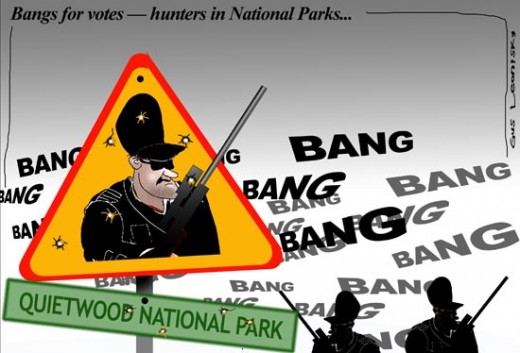
.
.
‘Greens oppose recreational hunting in national parks’
.
[Source: Marian Wilkinson, Environment Editor, Sydney Morning Herald, 20090612, ^http://www.smh.com.au/environment/conservation/greens-oppose-recreational-hunting-in-national-parks-20090611-c508.html]
.
A new bill that would open the state’s national parks and reserves to recreational hunters who could be licensed to shoot native animals and birds has been condemned by the NSW Greens, the Liberal Party and environmental groups.
The NSW Shooters Party has introduced the private members bill to Parliament. It allows for private game reserves to be set up for professional safari hunters, overturning NSW laws that prevent the enclosing of animals on land solely for hunting purposes. A Shooters Party MP, Robert Brown, said the bill would not allow the hunting of threatened species and, in the case of native waterfowl, licensed game hunters would be required to pass an official identification test of the ducks.
But the Opposition’s environment spokeswoman, Catherine Cusack, attacked the bill, saying key elements were unacceptable. “We totally reject the idea of shooting in national parks and the concept of shooting native animals in national parks is repugnant to almost anyone.”
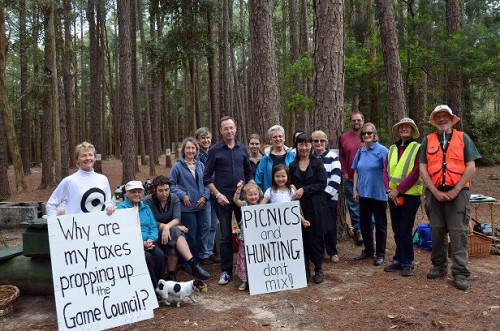
Among the birds and animals that could be hunted are the Australian wood duck, the chestnut teal and grey teal ducks, galahs, corellas and eastern grey, western grey and red kangaroos. The Shooters Party hopes to gain the Government’s support for the bill but the Environment Minister, Carmel Tebbutt, is already signalling she will oppose key provisions in it, including allowing recreational hunters into national parks and the hunting of native animals. Her spokeswoman said the Government would consider the bill’s merits but it did not support “the hunting of native animals or hunting in national parks“.
Mr Brown said the bill drew on many of the recommendations of a government-backed review of existing laws undertaken with staff from the NSW Department of Primary Industries and the Game Council.
He said that under his bill, the environment minister would be responsible for declaring any national park or reserve open to hunters. He told the Herald that opening national parks to recreational hunters to shoot feral animals would save the Government significant amounts of money and the hunting of native animals and birds in parks would require ministerial approval.
The Greens leader, Lee Rhiannon, called on Ms Tebbutt to reject the entire bill, not only the provisions concerning national parks. “Opposing shooting in national parks may well be a tactic Labor is using to divert attention from the fact it will support other equally regressive changes being pushed by the Shooters Party,” Ms Rhiannon said.
The Greens are also concerned about provisions in the bill that would make it an offence to approach anyone or interfere with anyone “lawfully hunting game animals” on any land that had been declared public hunting land.
.
.
‘Shooting in national parks dead: Macdonald’
.
[Source: AAP, 20090729, ^http://www.smh.com.au/environment/conservation/shooting-in-national-parks-dead-macdonald-20090729-e1an.html]
.
A deal with the Shooters’ Party that would allow hunting in national parks is unlikely, the NSW Government says. The Government withdrew its support for the proposal last month, prompting the Shooters to retract their support for legislation to privatise NSW Lotteries management. Primary Industries Minister Ian Macdonald said today the national parks proposal was all but dead in the water.
“The Government has been considering these issues for some time and has taken a policy position that they don’t want that type of shooting activity in national parks,” Mr Macdonald told reporters in Sydney.
“I wouldn’t say it is likely to change, but there again, there’s nothing in life that’s immutable.”
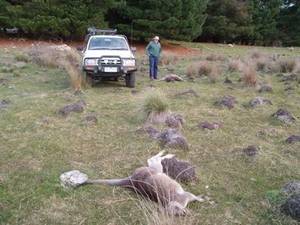
Kangaroos illegally shot through SE Forests National Park
.
.
Game and Feral Animal Control Repeal Bill 2010 – lapsed
.
On 23rd June 2010, then NSW Greens MP Lee Rhiannon introduced a private members bill to the NSW Parliament, ‘Game and Feral Animal Control Repeal Bill 2010’, designed to repeal the Game and Feral Animal Control Act 2002 and its regulations, to abolish the Game Council and to prohibit hunting for sporting or recreational purposes on national park estate land, Crown land and State forests. However although the Repeal Bill reached a second reading stage, the then Labor Premier Kristine Keneally suspended (proroged (suspended) the sitting of the NSW Parliament ahead of an election, and the Bill lapsed on 2nd September 201o.
It needs to be reinstated forthwith!
.
Overview of Bill
The objects of this Bill are as follows:
- To repeal the Game and Feral Animal Control Act 2002 and the regulations made under that Act
- To expressly abolish the Game Council and provide for the transfer of its assets, rights and liabilities to the Crown
- To prohibit hunting for sporting or recreational purposes on national park estate land, Crown land and State forests
.
‘Greens’ Bill abolishes Game Council, ends hunting in State Forests, NP‘
.
[Source: The Australian Greens, 20100624, ^http://greens.org.au/content/greens-bill-abolishes-game-council-ends-hunting-state-forests-np]
.
Greens MP Lee Rhiannon was last night given urgent leave by the NSW Upper House to introduce her private members bill to abolish the NSW Game Council and prohibit recreational hunting in national parks, state forests and public land.
The Game and Feral Animal Control Repeal Bill 2010 is now available.
“Feral animals are a significant environmental problem in Australia but the Games Council, set up as a favour by the Labor Party to the Shooters Party to shore up their vote, is a bankrupt vehicle for managing invasive species,” Ms Rhiannon said. “The more than $11 million in public funding and millions in loans spent propping up the Gaming Council since 2002 would be better spent developing an evidenced based, strategic plan using professionals to tackle invasive species.
“The Game Council was set up to be self funding, yet the Auditor General has noted its ongoing financial difficulties, with the government being forced to prop it up with loans and additional recurrent funding to manage ongoing debt problems.
“Former Premier Bob Carr’s establishment of the Game Council in 2002 was an act of unashamed capitulation to the gun and hunting lobbies, legitimising recreational animal cruelty while risking an increase in feral animal populations.
“The Greens Bill also prohibits recreational hunting in state forests, national parks and Crown Land.
“As part of the deal making between Labor and the Shooters Party, NSW’s state forests have been lately opened up to recreational shooters, risking public safety. “There is still currently a Shooters Party private members bill before parliament which if passed would broaden where recreational shooters can hunt to include national parks.
“The NSW government has agreed to various demands by the Shooters Party for changes to gun ownership laws in recent years and there is no guarantee that shooting in national parks will not be next on the list. “In the interests of the environment and good government NSW Labor should support the Greens’ bill to abolish the Game Council and ensure the professional and scientific management of invasive species in NSW,” Ms Rhiannon said.
.
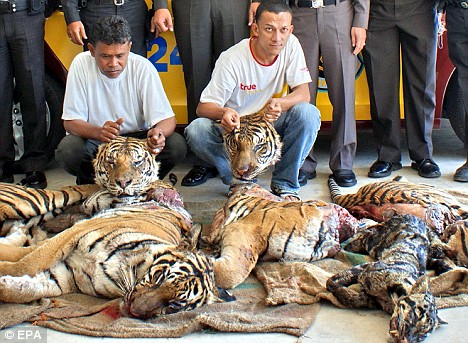
It’s 2011 and we’re still killing Tigers!
[‘Police Seize Firearms Used by Wildlife Officials to Fight Off Poachers‘ by Sarah Pappin, Bushwarriors, 20100716,
^http://bushwarriors.wordpress.com/tag/south-china-tiger/]
.
In only the last eight years, the Bengal Tiger population has decreased by over 61% and is now frighteningly close to extinction with only 1,400 of the cats left. Habitat loss and poaching are to blame for their decline. Nagarhole Tiger Reserve is home to the highest density of these tigers in all of India, attracting a heavy and constant flow of poachers. Forest officers tasked with protecting the National Park’s tiger population (and other wildlife) from the poachers are now impeded by a devastating combination of muddy monsoon conditions and a complete lack of defense.
Comments:
.
Arvind Telkar (20100717): “Poaching is one of the heinous crimes, which must be dealt with a very severe punishment. The law should be changed in such a manner, that he must think hundred times before aiming any wild animal.”
.
Franklin Joel (20100717): “Thank you very much for sharing,I am sharing this on my wall. Please do something to Stop Poaching, My eyes are wet seeing these pictures..The Hon. court should pronounce the highest punishment to these people….”
.
Anne Maher (20100719): “Absolute tragedy. Decisions made by idiots. They must be in on the corrupt poaching activities to leave the Wildlife rangers and the Tigers so unprotected. Spare us from brainless individuals.”
.
Amay (20100903): “What cruel people they are the biggest criminals i hav ever seen in my life how badly these people hav cut the tigers they truly deserve a capital punishment.”
.
Zachary (20101118): “What the hell is wrong with these people?! why don’t they do something to stop this? I don’t give a damn if they think that certain parts have special healing or good luck charms, this is wrong! This is just digusting.”
.
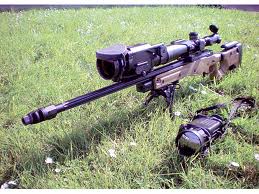 An effective tool against poachers An effective tool against poachers
.
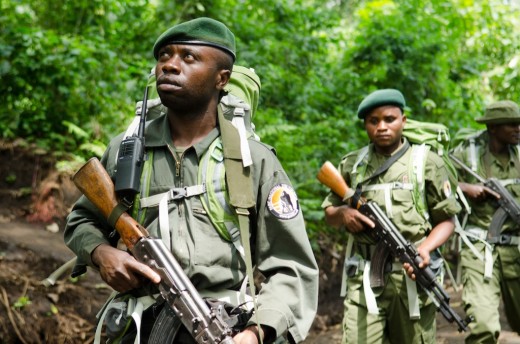 An effective but under-resourced force against poachers An effective but under-resourced force against poachers
.
Tags: animal cruelty, Australian Wood Duck, Bennetts Wallaby, Coalition of Law Abiding Sporting Shooters, Game and Feral Animal Control Amendment Bill 2009, Game and Feral Animal Control Repeal Bill 2010, hunting, hunting season, illegal shooting, Lee Rhiannon, national parks, NSW Game Council, NSW Government, Premier Nathan Rees, SE Forests National Park, Shooters and Fishers Party, still killing Tigers, weekend warriors, Wildlife, wildlife poaching
Posted in Africa, Birds (Australian), Birds (Migratory), Blue Mountains (AU), Elephants, Kangaroos and Macropods, Threats from Poaching and Poisoning | No Comments »
Add this post to Del.icio.us - Digg
Friday, July 22nd, 2011
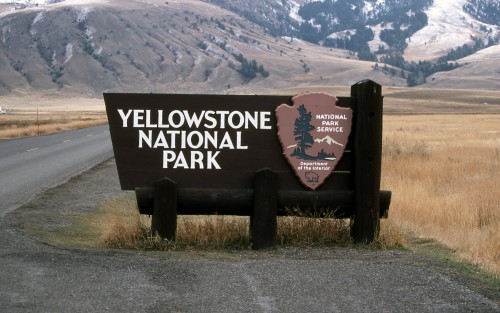 A proper ‘National Park” – Yellowstone National Park, USA A proper ‘National Park” – Yellowstone National Park, USA
© Photo by Jim Peaco, October 1992
[Source: http://www.longislandpress.com/wp-content/uploads/2011/07/14566-1.jpg]
.
One hundred and thirty nine years ago in 1872, Yellowstone National Park was established in the United States of America, leading the world in national conservation..
Australia supposedly followed suit quickly afterwards in 1879, declaring The National Park just south of Sydney the second national park in the world. It was renamed Royal National Park following Queen Elizabeth II’s visit in 1954.
But it is one thing to be seen to be following America in environmental leadership. It is publicly misleading to be disingenuous about ‘national‘ environmental protection.
 A ‘vulnerable’ Royal National Park (New South Wales, Australia)…
. A ‘vulnerable’ Royal National Park (New South Wales, Australia)…
.
National Parks in New South Wales are currently subject to the whims of incumbent State governments (both Labor and Liberal) and mining vested interests with such demands as to explore coal seam gas mining using fracking and chemical contamination from the likes of Apex Energy and Peabody Pacific’s joint Metropolitan Mine near Helensburgh in 2010.
National parks are typically large natural areas of land that are protected because they have unspoilt landscapes and a diverse number of native plants and animals. This means that commercial activities such as farming are prohibited and human activity is strictly monitored. The purpose of the ‘national parks’ concept is to protect native flora and fauna and their habitat.
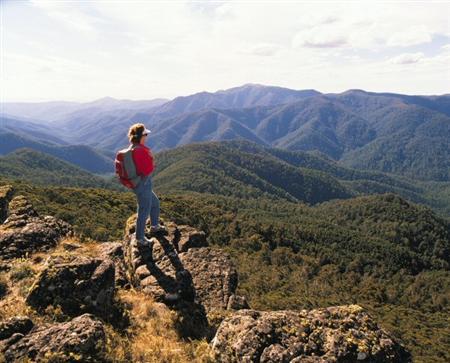 Victorian Alps Victorian Alps
.
Disturbingly, the powers that be in National Parks have grown a mindset that national parks are created primarily not for altruistic genuine conservation but for tourism – human use, benefit and exploitation. The sell is that national parks “are also there so Australians and foreign visitors can enjoy and learn about our unique environment, heritage and culture.”
Australia has over 500 national parks covering some 28 million hectares accounting for 4% of Australia’s land mass. But similarly disturbing is that the Australia legal concept of a ‘national park’ is one typically managed not by the national government, but a custodial responsibility delegated to the States and Territories of Australia. This means that across Australia, national parks are a hollow label for ‘reserve’, or in the case of Victoria’s Alpine National Park, an endless free cow paddock!
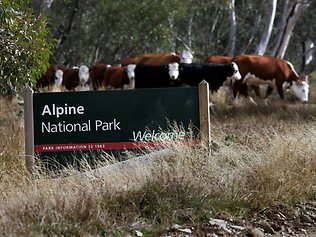 Cattle in the Alpine National Park?
© Photo Trevor Pinder Herald Sun 20110412 Cattle in the Alpine National Park?
© Photo Trevor Pinder Herald Sun 20110412
.
The state/territory custodial role for national parks is a left-over legacy from pre-Federation colonial Australia of the Nineteenth Century, in much the same way the Crown Land is a leftover legacy from when the Australian colonies were subservient to Britain. And sure enough, the management records demonstrate that the spirit of national park protection has not been respected by the state and territory custodial governments.
National Park ‘protection’ in the United States has national clout. But in Australia the term is politically expedient and superficial. This has caused the conservation movement to increasingly look to UNESCO World Heritage, because state and territory governments cannoit be trusted. ‘National park’ status has become meaningless. Just consider the Kakadu, Kosciuszko, and the Great Barrier Reef national parks and their abuse and mismanagement legacies!
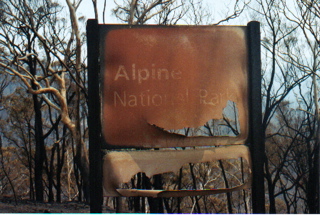 Alpine National Park
10,000 hectares was allowed to burn in 2003
~ so much for National Park ‘protection’, more like ‘abandonment’. Alpine National Park
10,000 hectares was allowed to burn in 2003
~ so much for National Park ‘protection’, more like ‘abandonment’.
.
.
Media Release by the National Parks Association of NSW:
[22 July 2011]
.
‘National Parks to be given national status’
.
National Parks Association of NSW CEO, Kevin Evans, has welcomed moves by Federal environment minister Tony Burke to add Commonwealth protection to Australia’s national parks.
“Stronger Federal protection for national parks is a groundbreaking move that will ensure the long-term integrity of Australia’s most loved natural places and vital habitat for threatened plants and animals,” Mr. Evans said.
“It will also make sure that politically motivated interference in park protection, including proposals for inappropriate tourism infrastructure, mining, cattle grazing and hunting will be more difficult in the future.
“We need to be clear that such proposals are not in the national interest,” Mr. Evans said. “Our protected areas are part of much bigger systems working at a landscape scale as the corner stone of Australia’s biodiversity conservation strategy.”
Speaking at the Sydney Institute on Thursday evening, Mr. Burke said “that there was a principle that once an area was protected there shall be no backward steps”.
He referred to the move by the Victorian government to return cattle to the Alpine National Parks earlier this year as treating a national park like a farm.
“Importantly, if implemented, this proposal would allow Australia to honour its commitment to international treaties designed to protect the world’s natural heritage” Mr. Evans said.
“It won’t change the way national parks are managed but as the minister says, it will make sure that there will be ‘no backward steps’ in that management.
“Most people already assume that national parks have national protection, as they do in most countries of the world. But almost all of our most important natural areas are actually set up and managed under the laws of each state and territory.”
Minister Burke announced last night that he has written to all states and territories seeking their views on a plan to amend federal laws to better protect national parks.
NPA encourages the NSW government to cooperate with the Federal environment minister on his proposal.
“Under the proposed federal law, states will still be in control of setting park boundaries, and there will be no change to existing activities in parks,” said Mr. Evans.
Mr. Evans said,
“What it does mean is that the protection offered by state laws will be backed up by national law.”
Our national parks will be truly part of our national heritage, securely protected by all Australians, for all Australians, for all time.
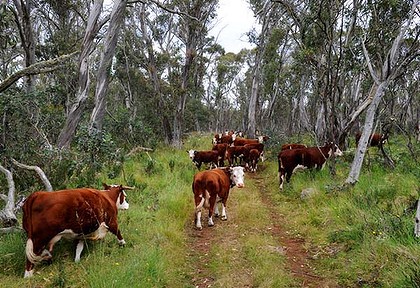
.
.
Editor’s comments:
This revelation confirms that Australians have been hoodwinked about ‘National Park Protection’ since 1879.
It one of the biggest greenwashing cons in Australian history. National Parks are but a convenient propaganda label until alternative land use demands are proposed.
The message is that the States and Territories simply cannot be trusted with Australia’s valuable natural heritage.
So if such jurisdictions are so unrepresentative of Australian values, then why do the States and Territories continue to exist?
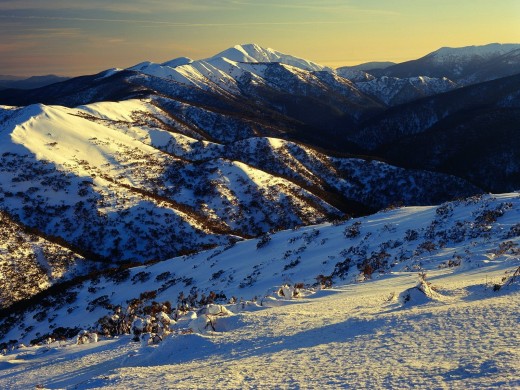 Sunrise on Mount Feathertop, Alpine National Park, Victoria
© http://good-wallpapers.com/places/4689. Sunrise on Mount Feathertop, Alpine National Park, Victoria
© http://good-wallpapers.com/places/4689.
.
.
Background:
.
‘High country ought stay a cattle no-go zone’
by Geoff Mosley, 20110308, The Age
.
‘The Baillieu government’s decision to reintroduce cattle into the Alpine National Park not only snubs 80 years of research highlighting the environmental damage they can do, it also undermines co-operative management of Australia’s alpine parks. This move was undertaken without any consultation with the federal government and, since the Alpine National Park is on the National Heritage List, all eyes are on whether Environment Minister Tony Burke will intervene to protect the area’s nationally significant natural heritage values.
 Victorian Premier, Ted Ballieu
© Sunday Herald Sun, 20110424 Victorian Premier, Ted Ballieu
© Sunday Herald Sun, 20110424
.
In deciding, Burke must take into account strong opposition to the Baillieu government’s move from the Australian Academy of Science and the World Commission on Protected Areas. These organisations have pointed to the bad example it would set when more than 3000 people attend the World National Parks Congress in Melbourne in 2014.
The planned ‘‘study’’ was also criticised by Melbourne University’s School of Land and Environment, whose acting head, associate professor Gerd Bossinger, said in an email: ‘‘much of the work being proposed has already been done’’. This response elicited a threat from the Baillieu government over millions of dollars in research funding.
Burke should also consider the damage that Victoria’s action would do to the co-ordinated approach to interstate management of the alpine parks, which has operated since 1986.
The states have been in charge of public land, including national parks, which by then had been established in several states, since Federation in 1901. Federation also introduced a possible role for the federal government in encouraging co-operative endeavours in heritage protection.
Co-operation did not come easily. The first initiative for a cross-state national park in the Alps came from the environment movement.
But, in 1943, the Victorian government rejected the proposed ‘Snowy-Indi National Park‘, embracing parts of the NSW (17,200 ha) and Victoria’s high country (22,000 ha), because of the ‘‘dangers to which large areas of country would be exposed by prohibiting occupation’’ – whatever that meant.
Instead the individual states established separate protected areas in their territories – Kosciusko State Park in 1944 (which became Kosciusko National Park in 1967), Gudgenby Nature Reserve in 1979 (became Namadgi National Park in 1984), and the Alpine National Park (formed from several disparate parks) in 1989.
The case for co-operative management of these adjacent alpine parks was obvious but who would initiate it?
The potential for Commonwealth leadership in such an enterprise was greatly increased in the 1970s with the passage of legislation to protect the national estate and with Australia’s ratification in 1974 of the World Heritage Convention. Apart from Queensland’s Great Barrier Reef and south-west Tasmania, there appeared to be no part of Australia more deserving of such a federal commitment than the Alps.
A clear case in point was the need for a uniform approach to alpine grazing. NSW ended the practice in Kosciusko National Park in 1969. The ACT followed suit. But the Victorian government dithered. So in 1984, I, as then director of the Australian Conservation Foundation, took 15 Victorian MPs on a tour of Kosciusko National Park. The visitors were so impressed by the recovery of the land after the removal of grazing that they agreed on a ‘‘Memorandum of Understanding for Co-operative Management of the Australian Alps National Parks’’, signed on July 15, 1986.
After an extensive review, in 2006 the Victorian government terminated the last of several of grazing licences in the Alpine National Park, bringing the state into line with NSW and the ACT. The Baillieu government’s reintroduction of grazing puts this hard-won co-operation in jeopardy.
Tony Burke’s decision also has consequences for the fate of the world heritage-listing proposal, in limbo since prime minister Bob Hawke announced in 1989 that the Australian Alps would be assessed.
World heritage listing of the Alps and adjacent forests – the ‘‘sea to snow concept’’ – would give the federal government enhanced power to act as Hawke did in 1983 to stop the Franklin Dam in Tasmania’s Wilderness World Heritage Area. Five reports later and nothing has happened. Meanwhile, the presence of cattle in the Alpine National Park could mean that a nomination would fail the ‘‘integrity’’ test for listing.
Burke has an opportunity to not only protect the Alpine National Park but to advance the overall cause of national heritage protection. If the word ‘‘national’’ means anything, he must do the right thing by the people of Australia and send the cattle back down the hill.’
– – – – – – – – – –
[Geoff Mosley has been involved with establishing and management national parks in the alpine areas of ACT, New South Wales and Victoria for 50 years. He was chief executive of the Australian Conservation Foundation from 1973 to 1986 and remains a member of the ACF council.]

.
.
.
Further Reading:
.
[1] ‘Burke demands a halt to alpine cattle grazing‘, 20110318, ABC Rural, ^http://www.abc.net.au/rural/news/content/201103/s3167854.htm
[2] ‘High country ought stay a cattle no-go zone‘, by Geoff Mosley, 20110308, ^http://www.smh.com.au/opinion/high-country-ought-stay-a-cattle-nogo-zone-20110307-1bka1.html
[3] ‘ Cattle Don’t Belong in Parks‘, Victorian National Parks Association ^ http://vnpa.org.au/page/bushwalking-and-activities/events/public-meeting-_-cattle-don%27t-belong-in-parks
[4] ‘ Coal Seam Gas Mining Threatens NSW and Australia‘, ^ http://www.stopcoalseamgas.com/helensburgh.php
[5] ‘ Wildlife under threat from shooters in NSW‘ (National Parks), ^ http://www.animalsaustralia.org/take_action/wildlife-under-threat-from-shooters–in-NSW/
[6] ‘ Uranium mining in Kakadu National Park‘, ^ http://en.wikipedia.org/wiki/Uranium_mining_in_Kakadu_National_Park
[7] ‘ Great Barrier Reef Environmental Threats‘ ^ http://www.workincairns.com/great-barrier-reef/environmental-threats.asp
[8] ‘ Human Impact on the Great Barrier Reef‘, University of Michigan, ^ http://sitemaker.umich.edu/gc2sec7labgroup3/pollution
.
(All references accessed 20110722)
.
22 July 2011
National Parks to be given national status
National Parks Association of NSW CEO, Kevin Evans, has welcomed moves by Federal environment minister Tony Burke to add Commonwealth protection to Australia’s national parks.
“Stronger Federal protection for national parks is a groundbreaking move that will ensure the long-term integrity of Australia’s most loved natural places and vital habitat for threatened plants and animals,” Mr. Evans said.
“It will also make sure that politically motivated interference in park protection, including proposals for inappropriate tourism infrastructure, mining, cattle grazing and hunting will be more difficult in the future.
“We need to be clear that such proposals are not in the national interest,” Mr. Evans said. “Our protected areas are part of much bigger systems working at a landscape scale as the corner stone of Australia’s biodiversity conservation strategy.”
Speaking at the Sydney Institute on Thursday evening, Mr. Burke said “that there was a principle that once an area was protected there shall be no backward steps”. He referred to the move by the Victorian government to return cattle to the Alpine National Parks earlier this year as treating a national park like a farm.
“Importantly, if implemented, this proposal would allow Australia to honour its commitment to international treaties designed to protect the world’s natural heritage” Mr. Evans said.
“It won’t change the way national parks are managed but as the minister says, it will make sure that there will be ‘no backward steps’ in that management.
“Most people already assume that national parks have national protection, as they do in most countries of the world. But almost all of our most important natural areas are actually set up and managed under the laws of each state and territory.”
Minister Burke announced last night that he has written to all states and territories seeking their views on a plan to amend federal laws to better protect national parks.
NPA encourages the NSW government to cooperate with the Federal environment minister on his proposal.
“Under the proposed federal law, states will still be in control of setting park boundaries, and there will be no change to existing activities in parks,” said Mr. Evans.
Mr. Evans said, “What it does mean is that the protection offered by state laws will be backed up by national law. Our national parks will be truly part of our national heritage, securely protected by all Australians, for all Australians, for all time.
“It will be good for nature protection and good for ecologically sustainable tourism,” said Mr. Evans.
Tags: Alpine National Park, Baillieu government, Cattle in the Alpine National Park, Cattle no-go zone, national parks, National Parks Association of NSW, NPA, Tony Burke, Victoria's High Country, World National Parks Congress 2014
Posted in Australian Alps (AU), Threats from Farming, Threats from Greenwashing, Threats from Mining, Threats from Tourism and Recreation | No Comments »
Add this post to Del.icio.us - Digg
|
|
 Smoking Ceremony or Smoke and Mirrors?
Staged for the delegates by National Parks and Wildlife Service of New South Wales (NPWS), somewhere outside Sydney, Australia
[Source: ‘Global First Nations environmentalists share stories at the World Parks Congress in Sydney.5:30’, ^https://twitter.com/nitvnews, 20141113]
Smoking Ceremony or Smoke and Mirrors?
Staged for the delegates by National Parks and Wildlife Service of New South Wales (NPWS), somewhere outside Sydney, Australia
[Source: ‘Global First Nations environmentalists share stories at the World Parks Congress in Sydney.5:30’, ^https://twitter.com/nitvnews, 20141113]
 Dredging the Great Barrier Reef for bulk export shipping
Dredging the Great Barrier Reef for bulk export shipping  Mass tourism operators good for the economy
Getting up close to protected Humpback Whales within their 100 metre Protected Area
Mass tourism operators good for the economy
Getting up close to protected Humpback Whales within their 100 metre Protected Area
 Protest to stop Queensland Resources Council dumping dredge spoil inside the Reef
Protest by Cairns and Far North Environment Centre (CAFNEC), June 2014
^http://cafnec.org.au/wp-content/uploads/2014/03/rally-promo-photo.jpg
Protest to stop Queensland Resources Council dumping dredge spoil inside the Reef
Protest by Cairns and Far North Environment Centre (CAFNEC), June 2014
^http://cafnec.org.au/wp-content/uploads/2014/03/rally-promo-photo.jpg
 White Lemuroid Possum
(Wet Tropics of Queensland World Heritage Area in Danger)
Has the white lemuroid possum become the first mammal to go extinct due to global warming?
White Lemuroid Possum
(Wet Tropics of Queensland World Heritage Area in Danger)
Has the white lemuroid possum become the first mammal to go extinct due to global warming?













 Conservation Hunting
Conservation Hunting






























































